Marketing Audit
VerifiedAdded on 2023/01/12
|17
|6524
|93
AI Summary
The retail and supermarket industry is characterized as fast-growing and encountered with a lot of competition who aim at increasing their market share to have better growth and expansion. The current research project is based on Lidl Company which consists of analysis of its micro and macro environment in order to develop better understanding about its strengths and competition that facilitates its better expansion in the market of UK.
Contribute Materials
Your contribution can guide someone’s learning journey. Share your
documents today.

Marketing Audit
Research Project MKT4002
Research Project MKT4002
Secure Best Marks with AI Grader
Need help grading? Try our AI Grader for instant feedback on your assignments.
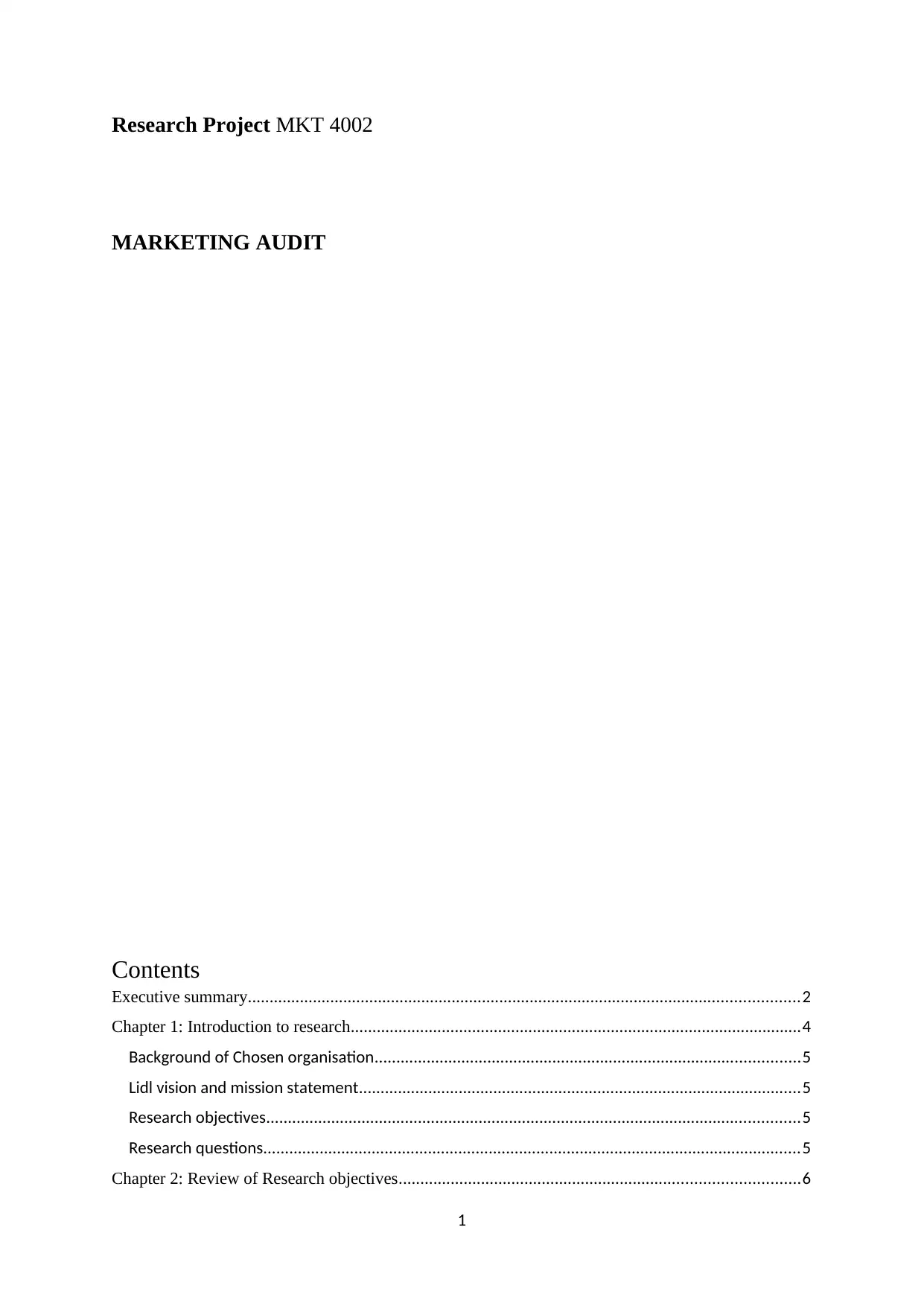
Research Project MKT 4002
MARKETING AUDIT
Contents
Executive summary...............................................................................................................................2
Chapter 1: Introduction to research........................................................................................................4
Background of Chosen organisation..................................................................................................5
Lidl vision and mission statement......................................................................................................5
Research objectives...........................................................................................................................5
Research questions............................................................................................................................5
Chapter 2: Review of Research objectives............................................................................................6
1
MARKETING AUDIT
Contents
Executive summary...............................................................................................................................2
Chapter 1: Introduction to research........................................................................................................4
Background of Chosen organisation..................................................................................................5
Lidl vision and mission statement......................................................................................................5
Research objectives...........................................................................................................................5
Research questions............................................................................................................................5
Chapter 2: Review of Research objectives............................................................................................6
1
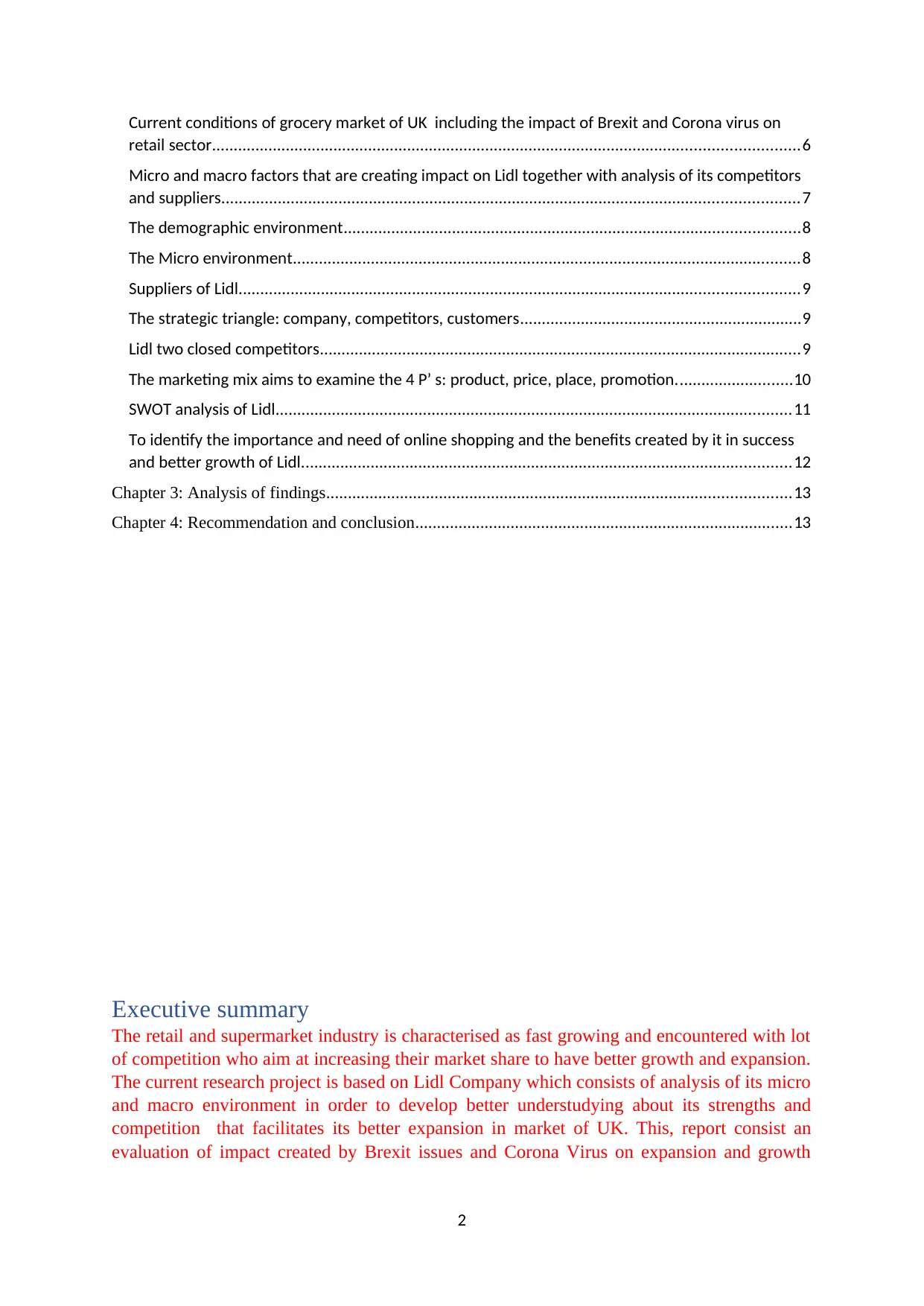
Current conditions of grocery market of UK including the impact of Brexit and Corona virus on
retail sector.......................................................................................................................................6
Micro and macro factors that are creating impact on Lidl together with analysis of its competitors
and suppliers.....................................................................................................................................7
The demographic environment.........................................................................................................8
The Micro environment.....................................................................................................................8
Suppliers of Lidl.................................................................................................................................9
The strategic triangle: company, competitors, customers.................................................................9
Lidl two closed competitors...............................................................................................................9
The marketing mix aims to examine the 4 P’ s: product, price, place, promotion...........................10
SWOT analysis of Lidl.......................................................................................................................11
To identify the importance and need of online shopping and the benefits created by it in success
and better growth of Lidl.................................................................................................................12
Chapter 3: Analysis of findings...........................................................................................................13
Chapter 4: Recommendation and conclusion.......................................................................................13
Executive summary
The retail and supermarket industry is characterised as fast growing and encountered with lot
of competition who aim at increasing their market share to have better growth and expansion.
The current research project is based on Lidl Company which consists of analysis of its micro
and macro environment in order to develop better understudying about its strengths and
competition that facilitates its better expansion in market of UK. This, report consist an
evaluation of impact created by Brexit issues and Corona Virus on expansion and growth
2
retail sector.......................................................................................................................................6
Micro and macro factors that are creating impact on Lidl together with analysis of its competitors
and suppliers.....................................................................................................................................7
The demographic environment.........................................................................................................8
The Micro environment.....................................................................................................................8
Suppliers of Lidl.................................................................................................................................9
The strategic triangle: company, competitors, customers.................................................................9
Lidl two closed competitors...............................................................................................................9
The marketing mix aims to examine the 4 P’ s: product, price, place, promotion...........................10
SWOT analysis of Lidl.......................................................................................................................11
To identify the importance and need of online shopping and the benefits created by it in success
and better growth of Lidl.................................................................................................................12
Chapter 3: Analysis of findings...........................................................................................................13
Chapter 4: Recommendation and conclusion.......................................................................................13
Executive summary
The retail and supermarket industry is characterised as fast growing and encountered with lot
of competition who aim at increasing their market share to have better growth and expansion.
The current research project is based on Lidl Company which consists of analysis of its micro
and macro environment in order to develop better understudying about its strengths and
competition that facilitates its better expansion in market of UK. This, report consist an
evaluation of impact created by Brexit issues and Corona Virus on expansion and growth
2
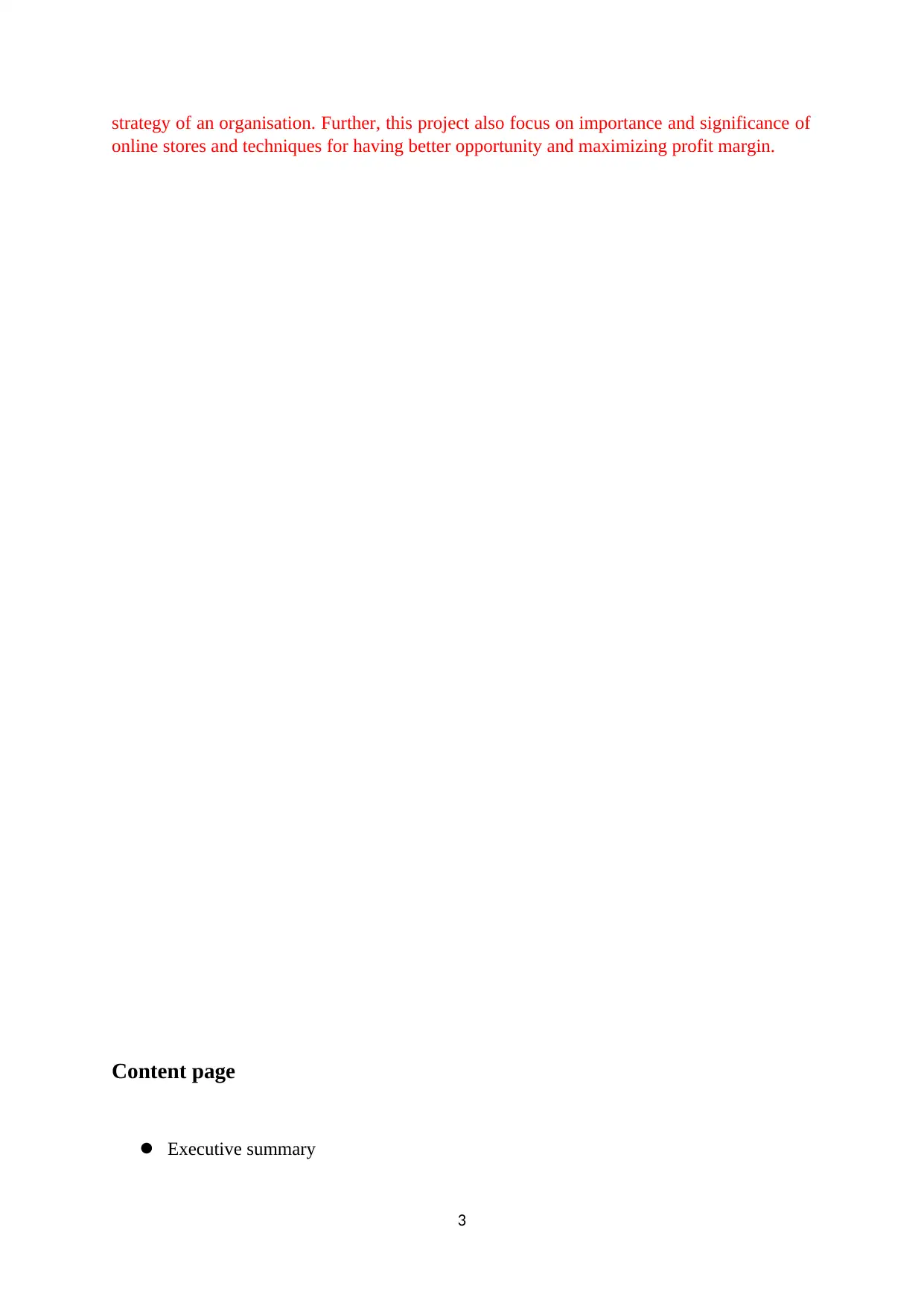
strategy of an organisation. Further, this project also focus on importance and significance of
online stores and techniques for having better opportunity and maximizing profit margin.
Content page
Executive summary
3
online stores and techniques for having better opportunity and maximizing profit margin.
Content page
Executive summary
3
Secure Best Marks with AI Grader
Need help grading? Try our AI Grader for instant feedback on your assignments.
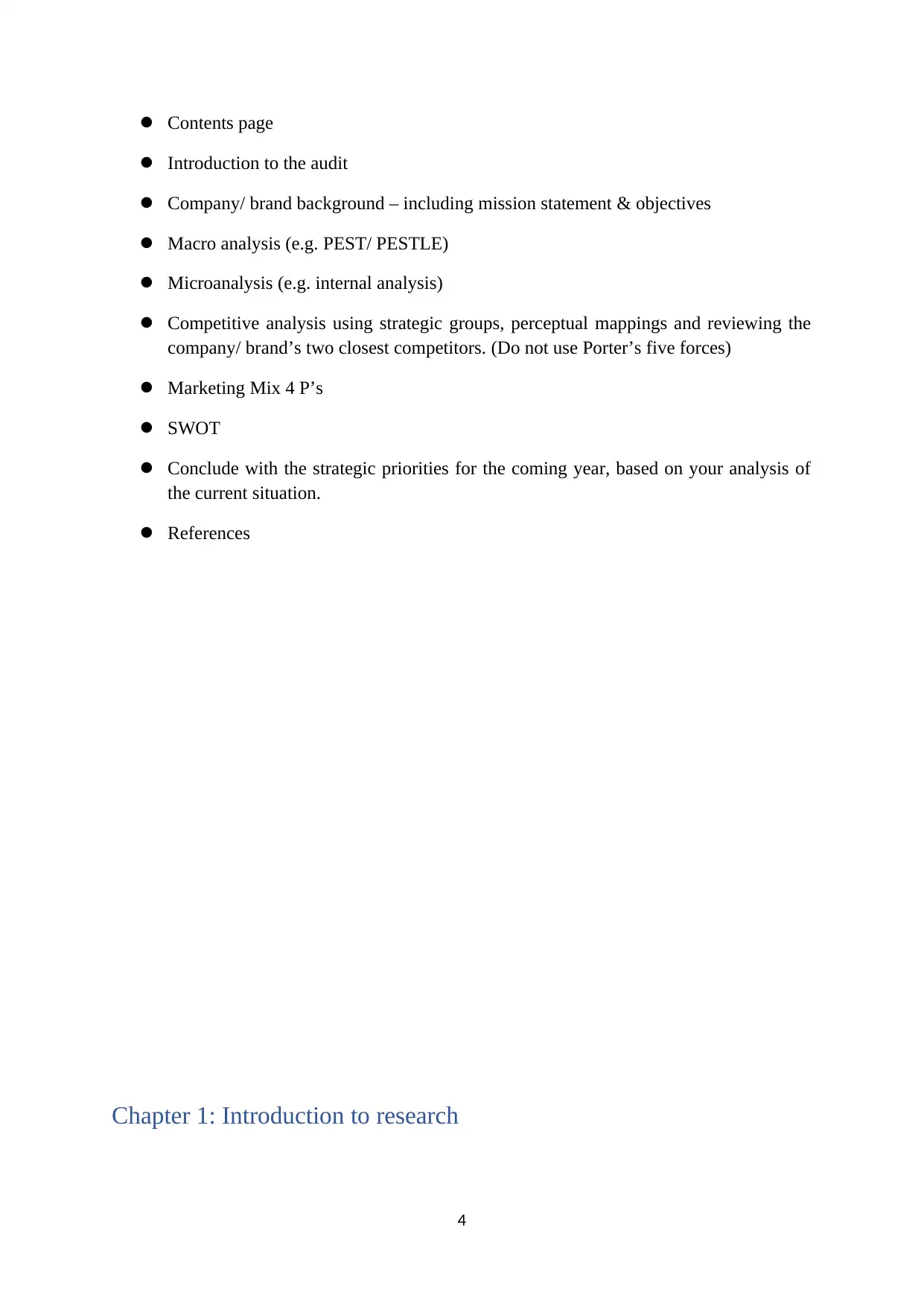
Contents page
Introduction to the audit
Company/ brand background – including mission statement & objectives
Macro analysis (e.g. PEST/ PESTLE)
Microanalysis (e.g. internal analysis)
Competitive analysis using strategic groups, perceptual mappings and reviewing the
company/ brand’s two closest competitors. (Do not use Porter’s five forces)
Marketing Mix 4 P’s
SWOT
Conclude with the strategic priorities for the coming year, based on your analysis of
the current situation.
References
Chapter 1: Introduction to research
4
Introduction to the audit
Company/ brand background – including mission statement & objectives
Macro analysis (e.g. PEST/ PESTLE)
Microanalysis (e.g. internal analysis)
Competitive analysis using strategic groups, perceptual mappings and reviewing the
company/ brand’s two closest competitors. (Do not use Porter’s five forces)
Marketing Mix 4 P’s
SWOT
Conclude with the strategic priorities for the coming year, based on your analysis of
the current situation.
References
Chapter 1: Introduction to research
4
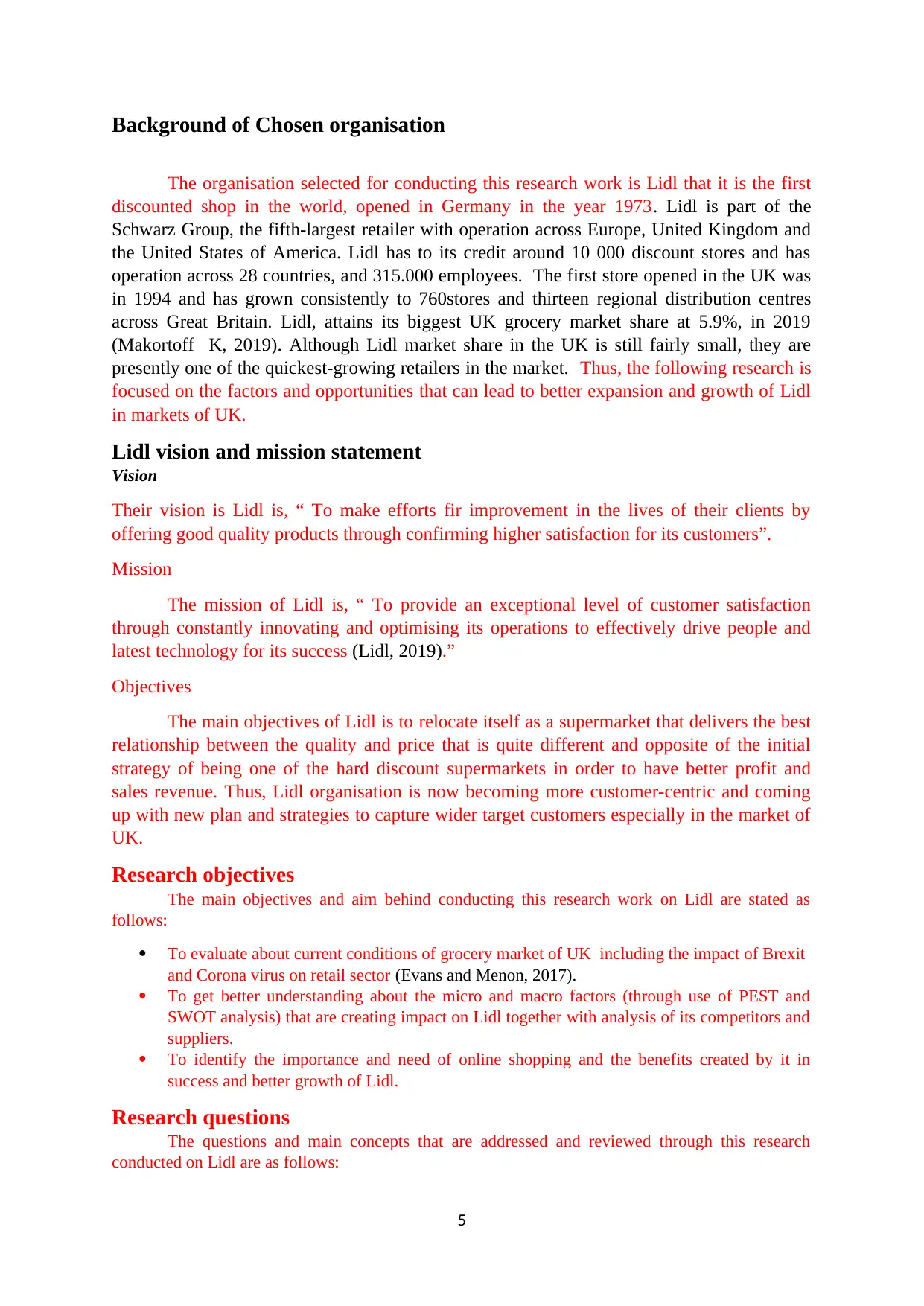
Background of Chosen organisation
The organisation selected for conducting this research work is Lidl that it is the first
discounted shop in the world, opened in Germany in the year 1973. Lidl is part of the
Schwarz Group, the fifth-largest retailer with operation across Europe, United Kingdom and
the United States of America. Lidl has to its credit around 10 000 discount stores and has
operation across 28 countries, and 315.000 employees. The first store opened in the UK was
in 1994 and has grown consistently to 760stores and thirteen regional distribution centres
across Great Britain. Lidl, attains its biggest UK grocery market share at 5.9%, in 2019
(Makortoff K, 2019). Although Lidl market share in the UK is still fairly small, they are
presently one of the quickest-growing retailers in the market. Thus, the following research is
focused on the factors and opportunities that can lead to better expansion and growth of Lidl
in markets of UK.
Lidl vision and mission statement
Vision
Their vision is Lidl is, “ To make efforts fir improvement in the lives of their clients by
offering good quality products through confirming higher satisfaction for its customers”.
Mission
The mission of Lidl is, “ To provide an exceptional level of customer satisfaction
through constantly innovating and optimising its operations to effectively drive people and
latest technology for its success (Lidl, 2019).”
Objectives
The main objectives of Lidl is to relocate itself as a supermarket that delivers the best
relationship between the quality and price that is quite different and opposite of the initial
strategy of being one of the hard discount supermarkets in order to have better profit and
sales revenue. Thus, Lidl organisation is now becoming more customer-centric and coming
up with new plan and strategies to capture wider target customers especially in the market of
UK.
Research objectives
The main objectives and aim behind conducting this research work on Lidl are stated as
follows:
To evaluate about current conditions of grocery market of UK including the impact of Brexit
and Corona virus on retail sector (Evans and Menon, 2017).
To get better understanding about the micro and macro factors (through use of PEST and
SWOT analysis) that are creating impact on Lidl together with analysis of its competitors and
suppliers.
To identify the importance and need of online shopping and the benefits created by it in
success and better growth of Lidl.
Research questions
The questions and main concepts that are addressed and reviewed through this research
conducted on Lidl are as follows:
5
The organisation selected for conducting this research work is Lidl that it is the first
discounted shop in the world, opened in Germany in the year 1973. Lidl is part of the
Schwarz Group, the fifth-largest retailer with operation across Europe, United Kingdom and
the United States of America. Lidl has to its credit around 10 000 discount stores and has
operation across 28 countries, and 315.000 employees. The first store opened in the UK was
in 1994 and has grown consistently to 760stores and thirteen regional distribution centres
across Great Britain. Lidl, attains its biggest UK grocery market share at 5.9%, in 2019
(Makortoff K, 2019). Although Lidl market share in the UK is still fairly small, they are
presently one of the quickest-growing retailers in the market. Thus, the following research is
focused on the factors and opportunities that can lead to better expansion and growth of Lidl
in markets of UK.
Lidl vision and mission statement
Vision
Their vision is Lidl is, “ To make efforts fir improvement in the lives of their clients by
offering good quality products through confirming higher satisfaction for its customers”.
Mission
The mission of Lidl is, “ To provide an exceptional level of customer satisfaction
through constantly innovating and optimising its operations to effectively drive people and
latest technology for its success (Lidl, 2019).”
Objectives
The main objectives of Lidl is to relocate itself as a supermarket that delivers the best
relationship between the quality and price that is quite different and opposite of the initial
strategy of being one of the hard discount supermarkets in order to have better profit and
sales revenue. Thus, Lidl organisation is now becoming more customer-centric and coming
up with new plan and strategies to capture wider target customers especially in the market of
UK.
Research objectives
The main objectives and aim behind conducting this research work on Lidl are stated as
follows:
To evaluate about current conditions of grocery market of UK including the impact of Brexit
and Corona virus on retail sector (Evans and Menon, 2017).
To get better understanding about the micro and macro factors (through use of PEST and
SWOT analysis) that are creating impact on Lidl together with analysis of its competitors and
suppliers.
To identify the importance and need of online shopping and the benefits created by it in
success and better growth of Lidl.
Research questions
The questions and main concepts that are addressed and reviewed through this research
conducted on Lidl are as follows:
5
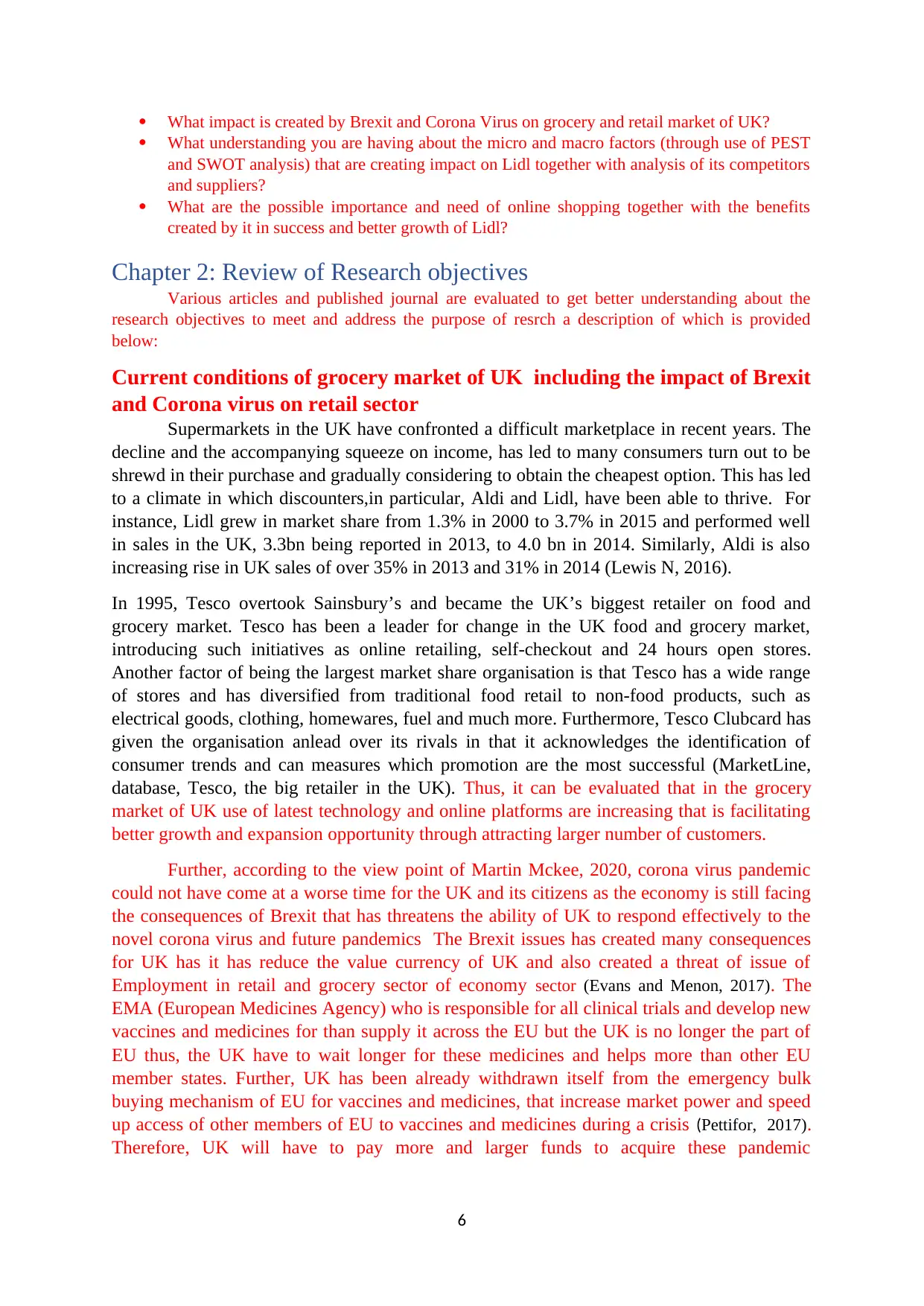
What impact is created by Brexit and Corona Virus on grocery and retail market of UK?
What understanding you are having about the micro and macro factors (through use of PEST
and SWOT analysis) that are creating impact on Lidl together with analysis of its competitors
and suppliers?
What are the possible importance and need of online shopping together with the benefits
created by it in success and better growth of Lidl?
Chapter 2: Review of Research objectives
Various articles and published journal are evaluated to get better understanding about the
research objectives to meet and address the purpose of resrch a description of which is provided
below:
Current conditions of grocery market of UK including the impact of Brexit
and Corona virus on retail sector
Supermarkets in the UK have confronted a difficult marketplace in recent years. The
decline and the accompanying squeeze on income, has led to many consumers turn out to be
shrewd in their purchase and gradually considering to obtain the cheapest option. This has led
to a climate in which discounters,in particular, Aldi and Lidl, have been able to thrive. For
instance, Lidl grew in market share from 1.3% in 2000 to 3.7% in 2015 and performed well
in sales in the UK, 3.3bn being reported in 2013, to 4.0 bn in 2014. Similarly, Aldi is also
increasing rise in UK sales of over 35% in 2013 and 31% in 2014 (Lewis N, 2016).
In 1995, Tesco overtook Sainsbury’s and became the UK’s biggest retailer on food and
grocery market. Tesco has been a leader for change in the UK food and grocery market,
introducing such initiatives as online retailing, self-checkout and 24 hours open stores.
Another factor of being the largest market share organisation is that Tesco has a wide range
of stores and has diversified from traditional food retail to non-food products, such as
electrical goods, clothing, homewares, fuel and much more. Furthermore, Tesco Clubcard has
given the organisation anlead over its rivals in that it acknowledges the identification of
consumer trends and can measures which promotion are the most successful (MarketLine,
database, Tesco, the big retailer in the UK). Thus, it can be evaluated that in the grocery
market of UK use of latest technology and online platforms are increasing that is facilitating
better growth and expansion opportunity through attracting larger number of customers.
Further, according to the view point of Martin Mckee, 2020, corona virus pandemic
could not have come at a worse time for the UK and its citizens as the economy is still facing
the consequences of Brexit that has threatens the ability of UK to respond effectively to the
novel corona virus and future pandemics The Brexit issues has created many consequences
for UK has it has reduce the value currency of UK and also created a threat of issue of
Employment in retail and grocery sector of economy sector (Evans and Menon, 2017). The
EMA (European Medicines Agency) who is responsible for all clinical trials and develop new
vaccines and medicines for than supply it across the EU but the UK is no longer the part of
EU thus, the UK have to wait longer for these medicines and helps more than other EU
member states. Further, UK has been already withdrawn itself from the emergency bulk
buying mechanism of EU for vaccines and medicines, that increase market power and speed
up access of other members of EU to vaccines and medicines during a crisis (Pettifor, 2017).
Therefore, UK will have to pay more and larger funds to acquire these pandemic
6
What understanding you are having about the micro and macro factors (through use of PEST
and SWOT analysis) that are creating impact on Lidl together with analysis of its competitors
and suppliers?
What are the possible importance and need of online shopping together with the benefits
created by it in success and better growth of Lidl?
Chapter 2: Review of Research objectives
Various articles and published journal are evaluated to get better understanding about the
research objectives to meet and address the purpose of resrch a description of which is provided
below:
Current conditions of grocery market of UK including the impact of Brexit
and Corona virus on retail sector
Supermarkets in the UK have confronted a difficult marketplace in recent years. The
decline and the accompanying squeeze on income, has led to many consumers turn out to be
shrewd in their purchase and gradually considering to obtain the cheapest option. This has led
to a climate in which discounters,in particular, Aldi and Lidl, have been able to thrive. For
instance, Lidl grew in market share from 1.3% in 2000 to 3.7% in 2015 and performed well
in sales in the UK, 3.3bn being reported in 2013, to 4.0 bn in 2014. Similarly, Aldi is also
increasing rise in UK sales of over 35% in 2013 and 31% in 2014 (Lewis N, 2016).
In 1995, Tesco overtook Sainsbury’s and became the UK’s biggest retailer on food and
grocery market. Tesco has been a leader for change in the UK food and grocery market,
introducing such initiatives as online retailing, self-checkout and 24 hours open stores.
Another factor of being the largest market share organisation is that Tesco has a wide range
of stores and has diversified from traditional food retail to non-food products, such as
electrical goods, clothing, homewares, fuel and much more. Furthermore, Tesco Clubcard has
given the organisation anlead over its rivals in that it acknowledges the identification of
consumer trends and can measures which promotion are the most successful (MarketLine,
database, Tesco, the big retailer in the UK). Thus, it can be evaluated that in the grocery
market of UK use of latest technology and online platforms are increasing that is facilitating
better growth and expansion opportunity through attracting larger number of customers.
Further, according to the view point of Martin Mckee, 2020, corona virus pandemic
could not have come at a worse time for the UK and its citizens as the economy is still facing
the consequences of Brexit that has threatens the ability of UK to respond effectively to the
novel corona virus and future pandemics The Brexit issues has created many consequences
for UK has it has reduce the value currency of UK and also created a threat of issue of
Employment in retail and grocery sector of economy sector (Evans and Menon, 2017). The
EMA (European Medicines Agency) who is responsible for all clinical trials and develop new
vaccines and medicines for than supply it across the EU but the UK is no longer the part of
EU thus, the UK have to wait longer for these medicines and helps more than other EU
member states. Further, UK has been already withdrawn itself from the emergency bulk
buying mechanism of EU for vaccines and medicines, that increase market power and speed
up access of other members of EU to vaccines and medicines during a crisis (Pettifor, 2017).
Therefore, UK will have to pay more and larger funds to acquire these pandemic
6
Paraphrase This Document
Need a fresh take? Get an instant paraphrase of this document with our AI Paraphraser
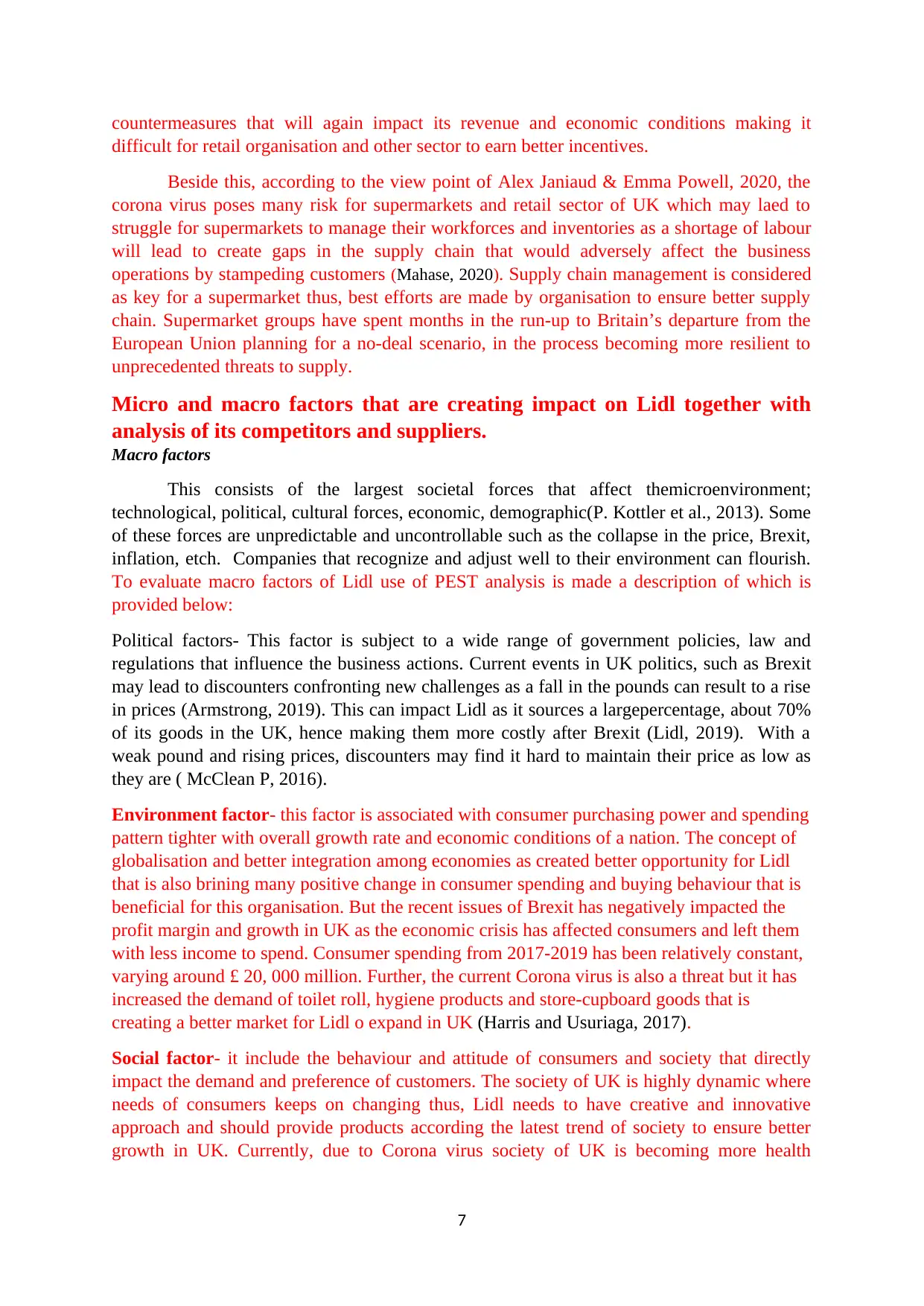
countermeasures that will again impact its revenue and economic conditions making it
difficult for retail organisation and other sector to earn better incentives.
Beside this, according to the view point of Alex Janiaud & Emma Powell, 2020, the
corona virus poses many risk for supermarkets and retail sector of UK which may laed to
struggle for supermarkets to manage their workforces and inventories as a shortage of labour
will lead to create gaps in the supply chain that would adversely affect the business
operations by stampeding customers (Mahase, 2020). Supply chain management is considered
as key for a supermarket thus, best efforts are made by organisation to ensure better supply
chain. Supermarket groups have spent months in the run-up to Britain’s departure from the
European Union planning for a no-deal scenario, in the process becoming more resilient to
unprecedented threats to supply.
Micro and macro factors that are creating impact on Lidl together with
analysis of its competitors and suppliers.
Macro factors
This consists of the largest societal forces that affect themicroenvironment;
technological, political, cultural forces, economic, demographic(P. Kottler et al., 2013). Some
of these forces are unpredictable and uncontrollable such as the collapse in the price, Brexit,
inflation, etch. Companies that recognize and adjust well to their environment can flourish.
To evaluate macro factors of Lidl use of PEST analysis is made a description of which is
provided below:
Political factors- This factor is subject to a wide range of government policies, law and
regulations that influence the business actions. Current events in UK politics, such as Brexit
may lead to discounters confronting new challenges as a fall in the pounds can result to a rise
in prices (Armstrong, 2019). This can impact Lidl as it sources a largepercentage, about 70%
of its goods in the UK, hence making them more costly after Brexit (Lidl, 2019). With a
weak pound and rising prices, discounters may find it hard to maintain their price as low as
they are ( McClean P, 2016).
Environment factor- this factor is associated with consumer purchasing power and spending
pattern tighter with overall growth rate and economic conditions of a nation. The concept of
globalisation and better integration among economies as created better opportunity for Lidl
that is also brining many positive change in consumer spending and buying behaviour that is
beneficial for this organisation. But the recent issues of Brexit has negatively impacted the
profit margin and growth in UK as the economic crisis has affected consumers and left them
with less income to spend. Consumer spending from 2017-2019 has been relatively constant,
varying around £ 20, 000 million. Further, the current Corona virus is also a threat but it has
increased the demand of toilet roll, hygiene products and store-cupboard goods that is
creating a better market for Lidl o expand in UK (Harris and Usuriaga, 2017).
Social factor- it include the behaviour and attitude of consumers and society that directly
impact the demand and preference of customers. The society of UK is highly dynamic where
needs of consumers keeps on changing thus, Lidl needs to have creative and innovative
approach and should provide products according the latest trend of society to ensure better
growth in UK. Currently, due to Corona virus society of UK is becoming more health
7
difficult for retail organisation and other sector to earn better incentives.
Beside this, according to the view point of Alex Janiaud & Emma Powell, 2020, the
corona virus poses many risk for supermarkets and retail sector of UK which may laed to
struggle for supermarkets to manage their workforces and inventories as a shortage of labour
will lead to create gaps in the supply chain that would adversely affect the business
operations by stampeding customers (Mahase, 2020). Supply chain management is considered
as key for a supermarket thus, best efforts are made by organisation to ensure better supply
chain. Supermarket groups have spent months in the run-up to Britain’s departure from the
European Union planning for a no-deal scenario, in the process becoming more resilient to
unprecedented threats to supply.
Micro and macro factors that are creating impact on Lidl together with
analysis of its competitors and suppliers.
Macro factors
This consists of the largest societal forces that affect themicroenvironment;
technological, political, cultural forces, economic, demographic(P. Kottler et al., 2013). Some
of these forces are unpredictable and uncontrollable such as the collapse in the price, Brexit,
inflation, etch. Companies that recognize and adjust well to their environment can flourish.
To evaluate macro factors of Lidl use of PEST analysis is made a description of which is
provided below:
Political factors- This factor is subject to a wide range of government policies, law and
regulations that influence the business actions. Current events in UK politics, such as Brexit
may lead to discounters confronting new challenges as a fall in the pounds can result to a rise
in prices (Armstrong, 2019). This can impact Lidl as it sources a largepercentage, about 70%
of its goods in the UK, hence making them more costly after Brexit (Lidl, 2019). With a
weak pound and rising prices, discounters may find it hard to maintain their price as low as
they are ( McClean P, 2016).
Environment factor- this factor is associated with consumer purchasing power and spending
pattern tighter with overall growth rate and economic conditions of a nation. The concept of
globalisation and better integration among economies as created better opportunity for Lidl
that is also brining many positive change in consumer spending and buying behaviour that is
beneficial for this organisation. But the recent issues of Brexit has negatively impacted the
profit margin and growth in UK as the economic crisis has affected consumers and left them
with less income to spend. Consumer spending from 2017-2019 has been relatively constant,
varying around £ 20, 000 million. Further, the current Corona virus is also a threat but it has
increased the demand of toilet roll, hygiene products and store-cupboard goods that is
creating a better market for Lidl o expand in UK (Harris and Usuriaga, 2017).
Social factor- it include the behaviour and attitude of consumers and society that directly
impact the demand and preference of customers. The society of UK is highly dynamic where
needs of consumers keeps on changing thus, Lidl needs to have creative and innovative
approach and should provide products according the latest trend of society to ensure better
growth in UK. Currently, due to Corona virus society of UK is becoming more health
7
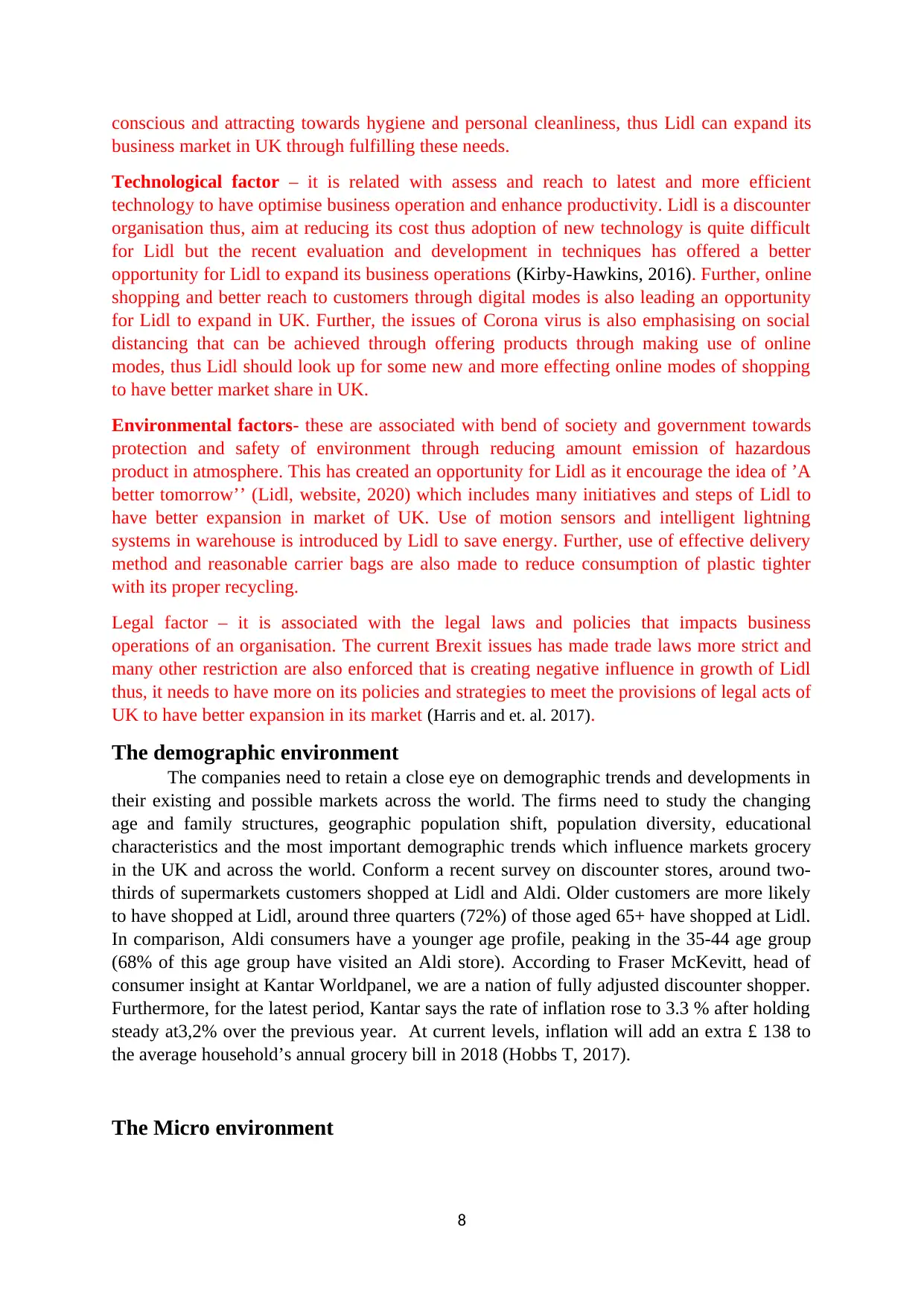
conscious and attracting towards hygiene and personal cleanliness, thus Lidl can expand its
business market in UK through fulfilling these needs.
Technological factor – it is related with assess and reach to latest and more efficient
technology to have optimise business operation and enhance productivity. Lidl is a discounter
organisation thus, aim at reducing its cost thus adoption of new technology is quite difficult
for Lidl but the recent evaluation and development in techniques has offered a better
opportunity for Lidl to expand its business operations (Kirby-Hawkins, 2016). Further, online
shopping and better reach to customers through digital modes is also leading an opportunity
for Lidl to expand in UK. Further, the issues of Corona virus is also emphasising on social
distancing that can be achieved through offering products through making use of online
modes, thus Lidl should look up for some new and more effecting online modes of shopping
to have better market share in UK.
Environmental factors- these are associated with bend of society and government towards
protection and safety of environment through reducing amount emission of hazardous
product in atmosphere. This has created an opportunity for Lidl as it encourage the idea of ’A
better tomorrow’’ (Lidl, website, 2020) which includes many initiatives and steps of Lidl to
have better expansion in market of UK. Use of motion sensors and intelligent lightning
systems in warehouse is introduced by Lidl to save energy. Further, use of effective delivery
method and reasonable carrier bags are also made to reduce consumption of plastic tighter
with its proper recycling.
Legal factor – it is associated with the legal laws and policies that impacts business
operations of an organisation. The current Brexit issues has made trade laws more strict and
many other restriction are also enforced that is creating negative influence in growth of Lidl
thus, it needs to have more on its policies and strategies to meet the provisions of legal acts of
UK to have better expansion in its market (Harris and et. al. 2017).
The demographic environment
The companies need to retain a close eye on demographic trends and developments in
their existing and possible markets across the world. The firms need to study the changing
age and family structures, geographic population shift, population diversity, educational
characteristics and the most important demographic trends which influence markets grocery
in the UK and across the world. Conform a recent survey on discounter stores, around two-
thirds of supermarkets customers shopped at Lidl and Aldi. Older customers are more likely
to have shopped at Lidl, around three quarters (72%) of those aged 65+ have shopped at Lidl.
In comparison, Aldi consumers have a younger age profile, peaking in the 35-44 age group
(68% of this age group have visited an Aldi store). According to Fraser McKevitt, head of
consumer insight at Kantar Worldpanel, we are a nation of fully adjusted discounter shopper.
Furthermore, for the latest period, Kantar says the rate of inflation rose to 3.3 % after holding
steady at3,2% over the previous year. At current levels, inflation will add an extra £ 138 to
the average household’s annual grocery bill in 2018 (Hobbs T, 2017).
The Micro environment
8
business market in UK through fulfilling these needs.
Technological factor – it is related with assess and reach to latest and more efficient
technology to have optimise business operation and enhance productivity. Lidl is a discounter
organisation thus, aim at reducing its cost thus adoption of new technology is quite difficult
for Lidl but the recent evaluation and development in techniques has offered a better
opportunity for Lidl to expand its business operations (Kirby-Hawkins, 2016). Further, online
shopping and better reach to customers through digital modes is also leading an opportunity
for Lidl to expand in UK. Further, the issues of Corona virus is also emphasising on social
distancing that can be achieved through offering products through making use of online
modes, thus Lidl should look up for some new and more effecting online modes of shopping
to have better market share in UK.
Environmental factors- these are associated with bend of society and government towards
protection and safety of environment through reducing amount emission of hazardous
product in atmosphere. This has created an opportunity for Lidl as it encourage the idea of ’A
better tomorrow’’ (Lidl, website, 2020) which includes many initiatives and steps of Lidl to
have better expansion in market of UK. Use of motion sensors and intelligent lightning
systems in warehouse is introduced by Lidl to save energy. Further, use of effective delivery
method and reasonable carrier bags are also made to reduce consumption of plastic tighter
with its proper recycling.
Legal factor – it is associated with the legal laws and policies that impacts business
operations of an organisation. The current Brexit issues has made trade laws more strict and
many other restriction are also enforced that is creating negative influence in growth of Lidl
thus, it needs to have more on its policies and strategies to meet the provisions of legal acts of
UK to have better expansion in its market (Harris and et. al. 2017).
The demographic environment
The companies need to retain a close eye on demographic trends and developments in
their existing and possible markets across the world. The firms need to study the changing
age and family structures, geographic population shift, population diversity, educational
characteristics and the most important demographic trends which influence markets grocery
in the UK and across the world. Conform a recent survey on discounter stores, around two-
thirds of supermarkets customers shopped at Lidl and Aldi. Older customers are more likely
to have shopped at Lidl, around three quarters (72%) of those aged 65+ have shopped at Lidl.
In comparison, Aldi consumers have a younger age profile, peaking in the 35-44 age group
(68% of this age group have visited an Aldi store). According to Fraser McKevitt, head of
consumer insight at Kantar Worldpanel, we are a nation of fully adjusted discounter shopper.
Furthermore, for the latest period, Kantar says the rate of inflation rose to 3.3 % after holding
steady at3,2% over the previous year. At current levels, inflation will add an extra £ 138 to
the average household’s annual grocery bill in 2018 (Hobbs T, 2017).
The Micro environment
8
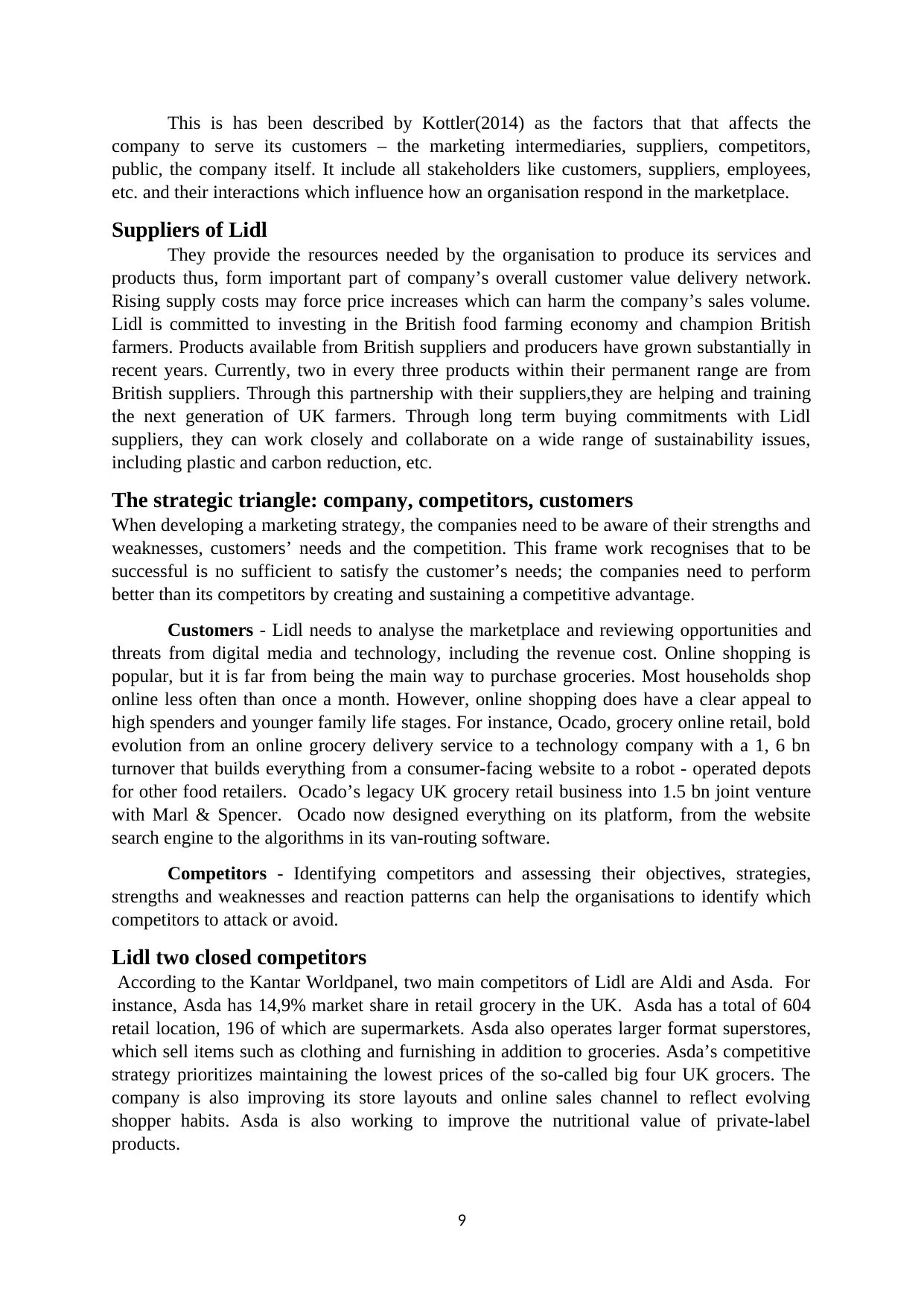
This is has been described by Kottler(2014) as the factors that that affects the
company to serve its customers – the marketing intermediaries, suppliers, competitors,
public, the company itself. It include all stakeholders like customers, suppliers, employees,
etc. and their interactions which influence how an organisation respond in the marketplace.
Suppliers of Lidl
They provide the resources needed by the organisation to produce its services and
products thus, form important part of company’s overall customer value delivery network.
Rising supply costs may force price increases which can harm the company’s sales volume.
Lidl is committed to investing in the British food farming economy and champion British
farmers. Products available from British suppliers and producers have grown substantially in
recent years. Currently, two in every three products within their permanent range are from
British suppliers. Through this partnership with their suppliers,they are helping and training
the next generation of UK farmers. Through long term buying commitments with Lidl
suppliers, they can work closely and collaborate on a wide range of sustainability issues,
including plastic and carbon reduction, etc.
The strategic triangle: company, competitors, customers
When developing a marketing strategy, the companies need to be aware of their strengths and
weaknesses, customers’ needs and the competition. This frame work recognises that to be
successful is no sufficient to satisfy the customer’s needs; the companies need to perform
better than its competitors by creating and sustaining a competitive advantage.
Customers - Lidl needs to analyse the marketplace and reviewing opportunities and
threats from digital media and technology, including the revenue cost. Online shopping is
popular, but it is far from being the main way to purchase groceries. Most households shop
online less often than once a month. However, online shopping does have a clear appeal to
high spenders and younger family life stages. For instance, Ocado, grocery online retail, bold
evolution from an online grocery delivery service to a technology company with a 1, 6 bn
turnover that builds everything from a consumer-facing website to a robot - operated depots
for other food retailers. Ocado’s legacy UK grocery retail business into 1.5 bn joint venture
with Marl & Spencer. Ocado now designed everything on its platform, from the website
search engine to the algorithms in its van-routing software.
Competitors - Identifying competitors and assessing their objectives, strategies,
strengths and weaknesses and reaction patterns can help the organisations to identify which
competitors to attack or avoid.
Lidl two closed competitors
According to the Kantar Worldpanel, two main competitors of Lidl are Aldi and Asda. For
instance, Asda has 14,9% market share in retail grocery in the UK. Asda has a total of 604
retail location, 196 of which are supermarkets. Asda also operates larger format superstores,
which sell items such as clothing and furnishing in addition to groceries. Asda’s competitive
strategy prioritizes maintaining the lowest prices of the so-called big four UK grocers. The
company is also improving its store layouts and online sales channel to reflect evolving
shopper habits. Asda is also working to improve the nutritional value of private-label
products.
9
company to serve its customers – the marketing intermediaries, suppliers, competitors,
public, the company itself. It include all stakeholders like customers, suppliers, employees,
etc. and their interactions which influence how an organisation respond in the marketplace.
Suppliers of Lidl
They provide the resources needed by the organisation to produce its services and
products thus, form important part of company’s overall customer value delivery network.
Rising supply costs may force price increases which can harm the company’s sales volume.
Lidl is committed to investing in the British food farming economy and champion British
farmers. Products available from British suppliers and producers have grown substantially in
recent years. Currently, two in every three products within their permanent range are from
British suppliers. Through this partnership with their suppliers,they are helping and training
the next generation of UK farmers. Through long term buying commitments with Lidl
suppliers, they can work closely and collaborate on a wide range of sustainability issues,
including plastic and carbon reduction, etc.
The strategic triangle: company, competitors, customers
When developing a marketing strategy, the companies need to be aware of their strengths and
weaknesses, customers’ needs and the competition. This frame work recognises that to be
successful is no sufficient to satisfy the customer’s needs; the companies need to perform
better than its competitors by creating and sustaining a competitive advantage.
Customers - Lidl needs to analyse the marketplace and reviewing opportunities and
threats from digital media and technology, including the revenue cost. Online shopping is
popular, but it is far from being the main way to purchase groceries. Most households shop
online less often than once a month. However, online shopping does have a clear appeal to
high spenders and younger family life stages. For instance, Ocado, grocery online retail, bold
evolution from an online grocery delivery service to a technology company with a 1, 6 bn
turnover that builds everything from a consumer-facing website to a robot - operated depots
for other food retailers. Ocado’s legacy UK grocery retail business into 1.5 bn joint venture
with Marl & Spencer. Ocado now designed everything on its platform, from the website
search engine to the algorithms in its van-routing software.
Competitors - Identifying competitors and assessing their objectives, strategies,
strengths and weaknesses and reaction patterns can help the organisations to identify which
competitors to attack or avoid.
Lidl two closed competitors
According to the Kantar Worldpanel, two main competitors of Lidl are Aldi and Asda. For
instance, Asda has 14,9% market share in retail grocery in the UK. Asda has a total of 604
retail location, 196 of which are supermarkets. Asda also operates larger format superstores,
which sell items such as clothing and furnishing in addition to groceries. Asda’s competitive
strategy prioritizes maintaining the lowest prices of the so-called big four UK grocers. The
company is also improving its store layouts and online sales channel to reflect evolving
shopper habits. Asda is also working to improve the nutritional value of private-label
products.
9
Secure Best Marks with AI Grader
Need help grading? Try our AI Grader for instant feedback on your assignments.
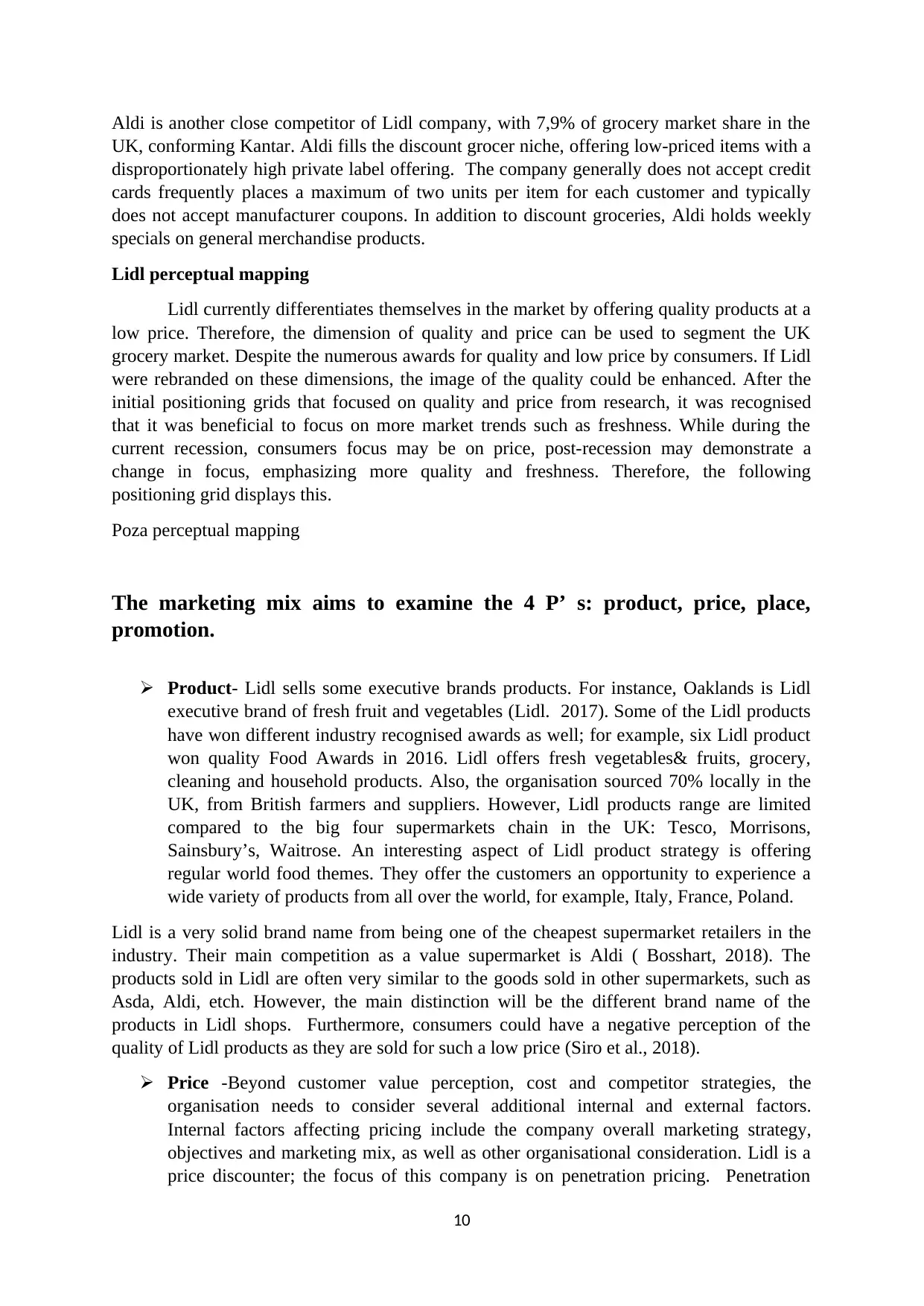
Aldi is another close competitor of Lidl company, with 7,9% of grocery market share in the
UK, conforming Kantar. Aldi fills the discount grocer niche, offering low-priced items with a
disproportionately high private label offering. The company generally does not accept credit
cards frequently places a maximum of two units per item for each customer and typically
does not accept manufacturer coupons. In addition to discount groceries, Aldi holds weekly
specials on general merchandise products.
Lidl perceptual mapping
Lidl currently differentiates themselves in the market by offering quality products at a
low price. Therefore, the dimension of quality and price can be used to segment the UK
grocery market. Despite the numerous awards for quality and low price by consumers. If Lidl
were rebranded on these dimensions, the image of the quality could be enhanced. After the
initial positioning grids that focused on quality and price from research, it was recognised
that it was beneficial to focus on more market trends such as freshness. While during the
current recession, consumers focus may be on price, post-recession may demonstrate a
change in focus, emphasizing more quality and freshness. Therefore, the following
positioning grid displays this.
Poza perceptual mapping
The marketing mix aims to examine the 4 P’ s: product, price, place,
promotion.
Product- Lidl sells some executive brands products. For instance, Oaklands is Lidl
executive brand of fresh fruit and vegetables (Lidl. 2017). Some of the Lidl products
have won different industry recognised awards as well; for example, six Lidl product
won quality Food Awards in 2016. Lidl offers fresh vegetables& fruits, grocery,
cleaning and household products. Also, the organisation sourced 70% locally in the
UK, from British farmers and suppliers. However, Lidl products range are limited
compared to the big four supermarkets chain in the UK: Tesco, Morrisons,
Sainsbury’s, Waitrose. An interesting aspect of Lidl product strategy is offering
regular world food themes. They offer the customers an opportunity to experience a
wide variety of products from all over the world, for example, Italy, France, Poland.
Lidl is a very solid brand name from being one of the cheapest supermarket retailers in the
industry. Their main competition as a value supermarket is Aldi ( Bosshart, 2018). The
products sold in Lidl are often very similar to the goods sold in other supermarkets, such as
Asda, Aldi, etch. However, the main distinction will be the different brand name of the
products in Lidl shops. Furthermore, consumers could have a negative perception of the
quality of Lidl products as they are sold for such a low price (Siro et al., 2018).
Price -Beyond customer value perception, cost and competitor strategies, the
organisation needs to consider several additional internal and external factors.
Internal factors affecting pricing include the company overall marketing strategy,
objectives and marketing mix, as well as other organisational consideration. Lidl is a
price discounter; the focus of this company is on penetration pricing. Penetration
10
UK, conforming Kantar. Aldi fills the discount grocer niche, offering low-priced items with a
disproportionately high private label offering. The company generally does not accept credit
cards frequently places a maximum of two units per item for each customer and typically
does not accept manufacturer coupons. In addition to discount groceries, Aldi holds weekly
specials on general merchandise products.
Lidl perceptual mapping
Lidl currently differentiates themselves in the market by offering quality products at a
low price. Therefore, the dimension of quality and price can be used to segment the UK
grocery market. Despite the numerous awards for quality and low price by consumers. If Lidl
were rebranded on these dimensions, the image of the quality could be enhanced. After the
initial positioning grids that focused on quality and price from research, it was recognised
that it was beneficial to focus on more market trends such as freshness. While during the
current recession, consumers focus may be on price, post-recession may demonstrate a
change in focus, emphasizing more quality and freshness. Therefore, the following
positioning grid displays this.
Poza perceptual mapping
The marketing mix aims to examine the 4 P’ s: product, price, place,
promotion.
Product- Lidl sells some executive brands products. For instance, Oaklands is Lidl
executive brand of fresh fruit and vegetables (Lidl. 2017). Some of the Lidl products
have won different industry recognised awards as well; for example, six Lidl product
won quality Food Awards in 2016. Lidl offers fresh vegetables& fruits, grocery,
cleaning and household products. Also, the organisation sourced 70% locally in the
UK, from British farmers and suppliers. However, Lidl products range are limited
compared to the big four supermarkets chain in the UK: Tesco, Morrisons,
Sainsbury’s, Waitrose. An interesting aspect of Lidl product strategy is offering
regular world food themes. They offer the customers an opportunity to experience a
wide variety of products from all over the world, for example, Italy, France, Poland.
Lidl is a very solid brand name from being one of the cheapest supermarket retailers in the
industry. Their main competition as a value supermarket is Aldi ( Bosshart, 2018). The
products sold in Lidl are often very similar to the goods sold in other supermarkets, such as
Asda, Aldi, etch. However, the main distinction will be the different brand name of the
products in Lidl shops. Furthermore, consumers could have a negative perception of the
quality of Lidl products as they are sold for such a low price (Siro et al., 2018).
Price -Beyond customer value perception, cost and competitor strategies, the
organisation needs to consider several additional internal and external factors.
Internal factors affecting pricing include the company overall marketing strategy,
objectives and marketing mix, as well as other organisational consideration. Lidl is a
price discounter; the focus of this company is on penetration pricing. Penetration
10
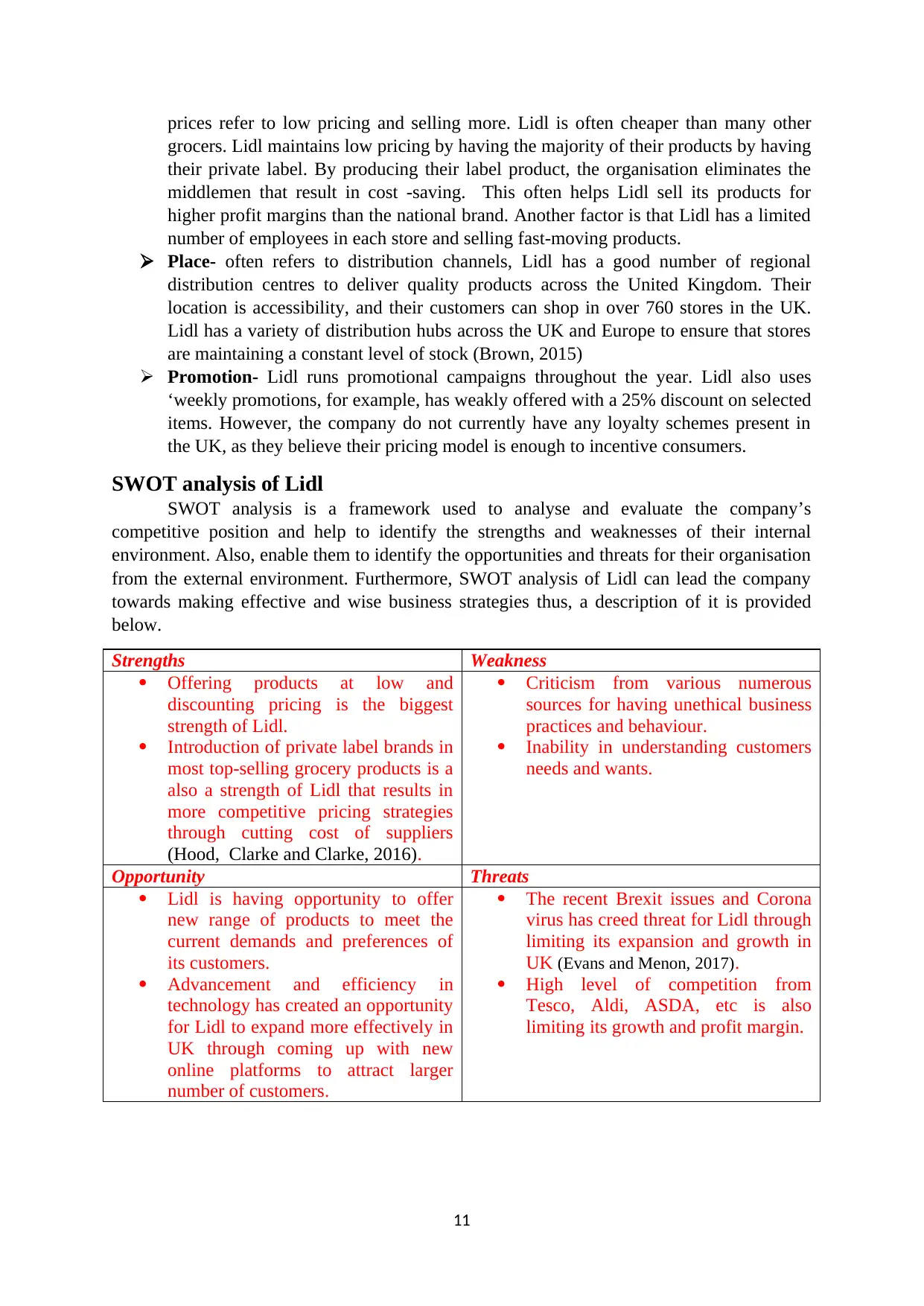
prices refer to low pricing and selling more. Lidl is often cheaper than many other
grocers. Lidl maintains low pricing by having the majority of their products by having
their private label. By producing their label product, the organisation eliminates the
middlemen that result in cost -saving. This often helps Lidl sell its products for
higher profit margins than the national brand. Another factor is that Lidl has a limited
number of employees in each store and selling fast-moving products.
Place- often refers to distribution channels, Lidl has a good number of regional
distribution centres to deliver quality products across the United Kingdom. Their
location is accessibility, and their customers can shop in over 760 stores in the UK.
Lidl has a variety of distribution hubs across the UK and Europe to ensure that stores
are maintaining a constant level of stock (Brown, 2015)
Promotion- Lidl runs promotional campaigns throughout the year. Lidl also uses
‘weekly promotions, for example, has weakly offered with a 25% discount on selected
items. However, the company do not currently have any loyalty schemes present in
the UK, as they believe their pricing model is enough to incentive consumers.
SWOT analysis of Lidl
SWOT analysis is a framework used to analyse and evaluate the company’s
competitive position and help to identify the strengths and weaknesses of their internal
environment. Also, enable them to identify the opportunities and threats for their organisation
from the external environment. Furthermore, SWOT analysis of Lidl can lead the company
towards making effective and wise business strategies thus, a description of it is provided
below.
Strengths Weakness
Offering products at low and
discounting pricing is the biggest
strength of Lidl.
Introduction of private label brands in
most top-selling grocery products is a
also a strength of Lidl that results in
more competitive pricing strategies
through cutting cost of suppliers
(Hood, Clarke and Clarke, 2016).
Criticism from various numerous
sources for having unethical business
practices and behaviour.
Inability in understanding customers
needs and wants.
Opportunity Threats
Lidl is having opportunity to offer
new range of products to meet the
current demands and preferences of
its customers.
Advancement and efficiency in
technology has created an opportunity
for Lidl to expand more effectively in
UK through coming up with new
online platforms to attract larger
number of customers.
The recent Brexit issues and Corona
virus has creed threat for Lidl through
limiting its expansion and growth in
UK (Evans and Menon, 2017).
High level of competition from
Tesco, Aldi, ASDA, etc is also
limiting its growth and profit margin.
11
grocers. Lidl maintains low pricing by having the majority of their products by having
their private label. By producing their label product, the organisation eliminates the
middlemen that result in cost -saving. This often helps Lidl sell its products for
higher profit margins than the national brand. Another factor is that Lidl has a limited
number of employees in each store and selling fast-moving products.
Place- often refers to distribution channels, Lidl has a good number of regional
distribution centres to deliver quality products across the United Kingdom. Their
location is accessibility, and their customers can shop in over 760 stores in the UK.
Lidl has a variety of distribution hubs across the UK and Europe to ensure that stores
are maintaining a constant level of stock (Brown, 2015)
Promotion- Lidl runs promotional campaigns throughout the year. Lidl also uses
‘weekly promotions, for example, has weakly offered with a 25% discount on selected
items. However, the company do not currently have any loyalty schemes present in
the UK, as they believe their pricing model is enough to incentive consumers.
SWOT analysis of Lidl
SWOT analysis is a framework used to analyse and evaluate the company’s
competitive position and help to identify the strengths and weaknesses of their internal
environment. Also, enable them to identify the opportunities and threats for their organisation
from the external environment. Furthermore, SWOT analysis of Lidl can lead the company
towards making effective and wise business strategies thus, a description of it is provided
below.
Strengths Weakness
Offering products at low and
discounting pricing is the biggest
strength of Lidl.
Introduction of private label brands in
most top-selling grocery products is a
also a strength of Lidl that results in
more competitive pricing strategies
through cutting cost of suppliers
(Hood, Clarke and Clarke, 2016).
Criticism from various numerous
sources for having unethical business
practices and behaviour.
Inability in understanding customers
needs and wants.
Opportunity Threats
Lidl is having opportunity to offer
new range of products to meet the
current demands and preferences of
its customers.
Advancement and efficiency in
technology has created an opportunity
for Lidl to expand more effectively in
UK through coming up with new
online platforms to attract larger
number of customers.
The recent Brexit issues and Corona
virus has creed threat for Lidl through
limiting its expansion and growth in
UK (Evans and Menon, 2017).
High level of competition from
Tesco, Aldi, ASDA, etc is also
limiting its growth and profit margin.
11
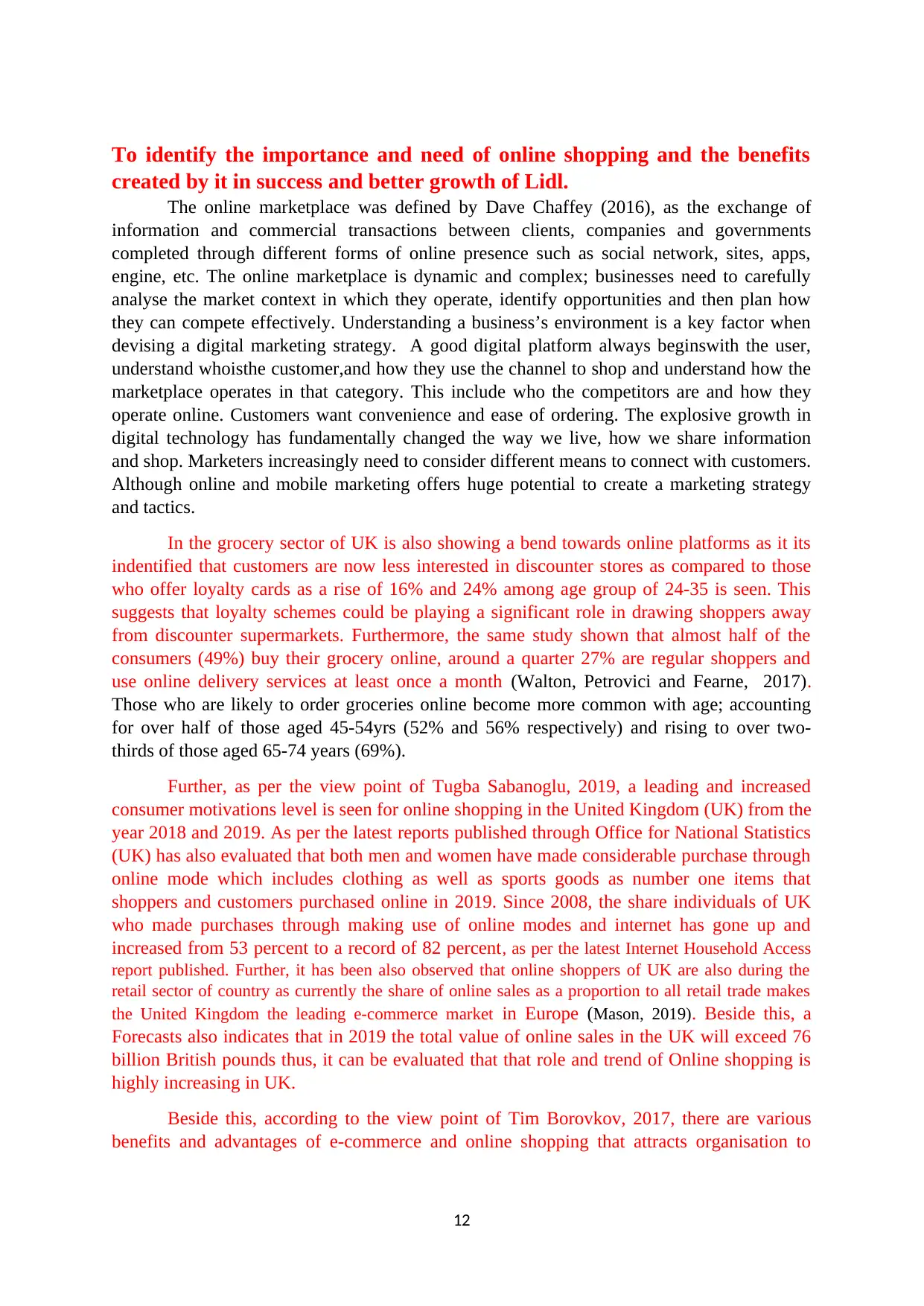
To identify the importance and need of online shopping and the benefits
created by it in success and better growth of Lidl.
The online marketplace was defined by Dave Chaffey (2016), as the exchange of
information and commercial transactions between clients, companies and governments
completed through different forms of online presence such as social network, sites, apps,
engine, etc. The online marketplace is dynamic and complex; businesses need to carefully
analyse the market context in which they operate, identify opportunities and then plan how
they can compete effectively. Understanding a business’s environment is a key factor when
devising a digital marketing strategy. A good digital platform always beginswith the user,
understand whoisthe customer,and how they use the channel to shop and understand how the
marketplace operates in that category. This include who the competitors are and how they
operate online. Customers want convenience and ease of ordering. The explosive growth in
digital technology has fundamentally changed the way we live, how we share information
and shop. Marketers increasingly need to consider different means to connect with customers.
Although online and mobile marketing offers huge potential to create a marketing strategy
and tactics.
In the grocery sector of UK is also showing a bend towards online platforms as it its
indentified that customers are now less interested in discounter stores as compared to those
who offer loyalty cards as a rise of 16% and 24% among age group of 24-35 is seen. This
suggests that loyalty schemes could be playing a significant role in drawing shoppers away
from discounter supermarkets. Furthermore, the same study shown that almost half of the
consumers (49%) buy their grocery online, around a quarter 27% are regular shoppers and
use online delivery services at least once a month (Walton, Petrovici and Fearne, 2017).
Those who are likely to order groceries online become more common with age; accounting
for over half of those aged 45-54yrs (52% and 56% respectively) and rising to over two-
thirds of those aged 65-74 years (69%).
Further, as per the view point of Tugba Sabanoglu, 2019, a leading and increased
consumer motivations level is seen for online shopping in the United Kingdom (UK) from the
year 2018 and 2019. As per the latest reports published through Office for National Statistics
(UK) has also evaluated that both men and women have made considerable purchase through
online mode which includes clothing as well as sports goods as number one items that
shoppers and customers purchased online in 2019. Since 2008, the share individuals of UK
who made purchases through making use of online modes and internet has gone up and
increased from 53 percent to a record of 82 percent, as per the latest Internet Household Access
report published. Further, it has been also observed that online shoppers of UK are also during the
retail sector of country as currently the share of online sales as a proportion to all retail trade makes
the United Kingdom the leading e-commerce market in Europe (Mason, 2019). Beside this, a
Forecasts also indicates that in 2019 the total value of online sales in the UK will exceed 76
billion British pounds thus, it can be evaluated that that role and trend of Online shopping is
highly increasing in UK.
Beside this, according to the view point of Tim Borovkov, 2017, there are various
benefits and advantages of e-commerce and online shopping that attracts organisation to
12
created by it in success and better growth of Lidl.
The online marketplace was defined by Dave Chaffey (2016), as the exchange of
information and commercial transactions between clients, companies and governments
completed through different forms of online presence such as social network, sites, apps,
engine, etc. The online marketplace is dynamic and complex; businesses need to carefully
analyse the market context in which they operate, identify opportunities and then plan how
they can compete effectively. Understanding a business’s environment is a key factor when
devising a digital marketing strategy. A good digital platform always beginswith the user,
understand whoisthe customer,and how they use the channel to shop and understand how the
marketplace operates in that category. This include who the competitors are and how they
operate online. Customers want convenience and ease of ordering. The explosive growth in
digital technology has fundamentally changed the way we live, how we share information
and shop. Marketers increasingly need to consider different means to connect with customers.
Although online and mobile marketing offers huge potential to create a marketing strategy
and tactics.
In the grocery sector of UK is also showing a bend towards online platforms as it its
indentified that customers are now less interested in discounter stores as compared to those
who offer loyalty cards as a rise of 16% and 24% among age group of 24-35 is seen. This
suggests that loyalty schemes could be playing a significant role in drawing shoppers away
from discounter supermarkets. Furthermore, the same study shown that almost half of the
consumers (49%) buy their grocery online, around a quarter 27% are regular shoppers and
use online delivery services at least once a month (Walton, Petrovici and Fearne, 2017).
Those who are likely to order groceries online become more common with age; accounting
for over half of those aged 45-54yrs (52% and 56% respectively) and rising to over two-
thirds of those aged 65-74 years (69%).
Further, as per the view point of Tugba Sabanoglu, 2019, a leading and increased
consumer motivations level is seen for online shopping in the United Kingdom (UK) from the
year 2018 and 2019. As per the latest reports published through Office for National Statistics
(UK) has also evaluated that both men and women have made considerable purchase through
online mode which includes clothing as well as sports goods as number one items that
shoppers and customers purchased online in 2019. Since 2008, the share individuals of UK
who made purchases through making use of online modes and internet has gone up and
increased from 53 percent to a record of 82 percent, as per the latest Internet Household Access
report published. Further, it has been also observed that online shoppers of UK are also during the
retail sector of country as currently the share of online sales as a proportion to all retail trade makes
the United Kingdom the leading e-commerce market in Europe (Mason, 2019). Beside this, a
Forecasts also indicates that in 2019 the total value of online sales in the UK will exceed 76
billion British pounds thus, it can be evaluated that that role and trend of Online shopping is
highly increasing in UK.
Beside this, according to the view point of Tim Borovkov, 2017, there are various
benefits and advantages of e-commerce and online shopping that attracts organisation to
12
Paraphrase This Document
Need a fresh take? Get an instant paraphrase of this document with our AI Paraphraser
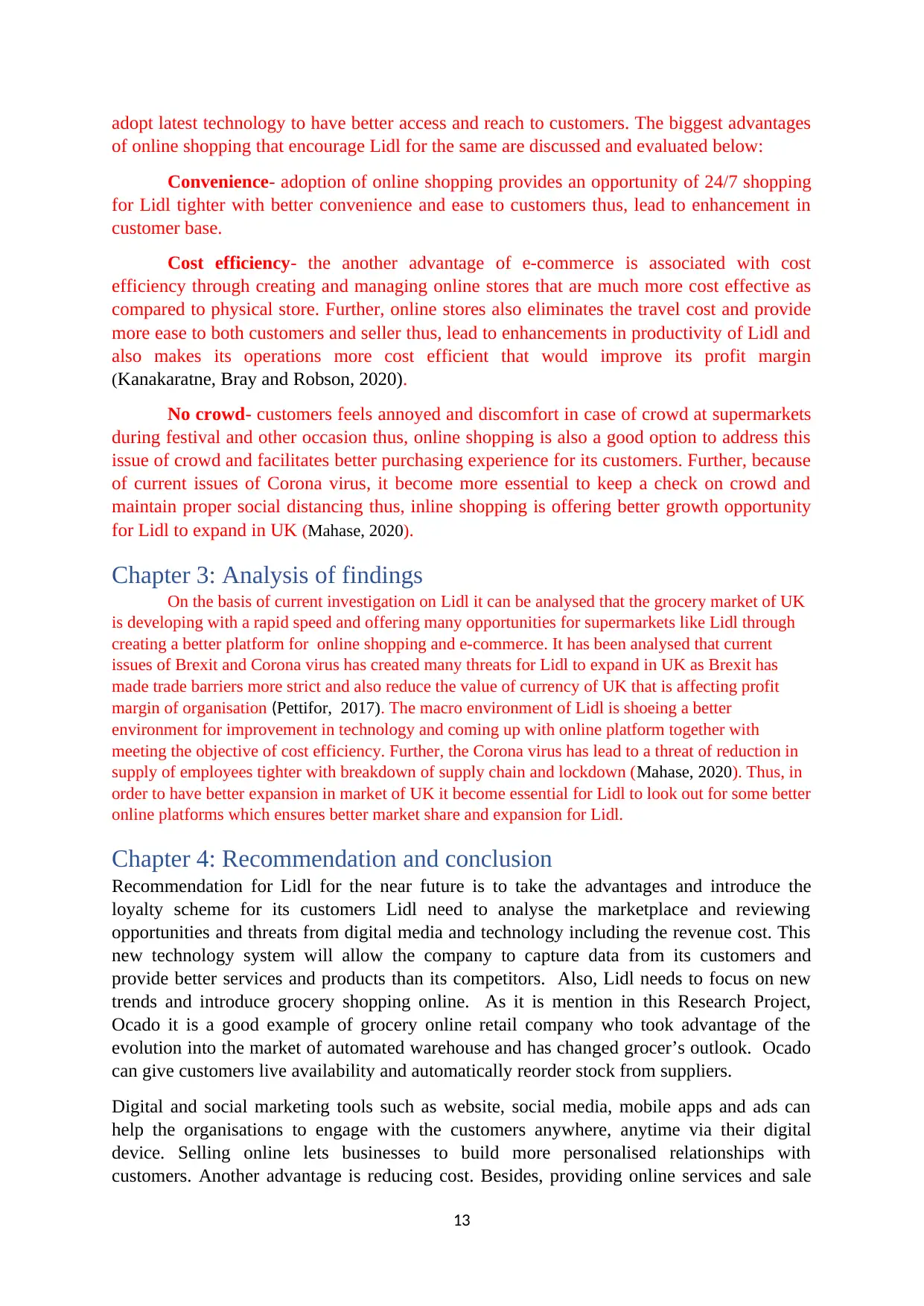
adopt latest technology to have better access and reach to customers. The biggest advantages
of online shopping that encourage Lidl for the same are discussed and evaluated below:
Convenience- adoption of online shopping provides an opportunity of 24/7 shopping
for Lidl tighter with better convenience and ease to customers thus, lead to enhancement in
customer base.
Cost efficiency- the another advantage of e-commerce is associated with cost
efficiency through creating and managing online stores that are much more cost effective as
compared to physical store. Further, online stores also eliminates the travel cost and provide
more ease to both customers and seller thus, lead to enhancements in productivity of Lidl and
also makes its operations more cost efficient that would improve its profit margin
(Kanakaratne, Bray and Robson, 2020).
No crowd- customers feels annoyed and discomfort in case of crowd at supermarkets
during festival and other occasion thus, online shopping is also a good option to address this
issue of crowd and facilitates better purchasing experience for its customers. Further, because
of current issues of Corona virus, it become more essential to keep a check on crowd and
maintain proper social distancing thus, inline shopping is offering better growth opportunity
for Lidl to expand in UK (Mahase, 2020).
Chapter 3: Analysis of findings
On the basis of current investigation on Lidl it can be analysed that the grocery market of UK
is developing with a rapid speed and offering many opportunities for supermarkets like Lidl through
creating a better platform for online shopping and e-commerce. It has been analysed that current
issues of Brexit and Corona virus has created many threats for Lidl to expand in UK as Brexit has
made trade barriers more strict and also reduce the value of currency of UK that is affecting profit
margin of organisation (Pettifor, 2017). The macro environment of Lidl is shoeing a better
environment for improvement in technology and coming up with online platform together with
meeting the objective of cost efficiency. Further, the Corona virus has lead to a threat of reduction in
supply of employees tighter with breakdown of supply chain and lockdown (Mahase, 2020). Thus, in
order to have better expansion in market of UK it become essential for Lidl to look out for some better
online platforms which ensures better market share and expansion for Lidl.
Chapter 4: Recommendation and conclusion
Recommendation for Lidl for the near future is to take the advantages and introduce the
loyalty scheme for its customers Lidl need to analyse the marketplace and reviewing
opportunities and threats from digital media and technology including the revenue cost. This
new technology system will allow the company to capture data from its customers and
provide better services and products than its competitors. Also, Lidl needs to focus on new
trends and introduce grocery shopping online. As it is mention in this Research Project,
Ocado it is a good example of grocery online retail company who took advantage of the
evolution into the market of automated warehouse and has changed grocer’s outlook. Ocado
can give customers live availability and automatically reorder stock from suppliers.
Digital and social marketing tools such as website, social media, mobile apps and ads can
help the organisations to engage with the customers anywhere, anytime via their digital
device. Selling online lets businesses to build more personalised relationships with
customers. Another advantage is reducing cost. Besides, providing online services and sale
13
of online shopping that encourage Lidl for the same are discussed and evaluated below:
Convenience- adoption of online shopping provides an opportunity of 24/7 shopping
for Lidl tighter with better convenience and ease to customers thus, lead to enhancement in
customer base.
Cost efficiency- the another advantage of e-commerce is associated with cost
efficiency through creating and managing online stores that are much more cost effective as
compared to physical store. Further, online stores also eliminates the travel cost and provide
more ease to both customers and seller thus, lead to enhancements in productivity of Lidl and
also makes its operations more cost efficient that would improve its profit margin
(Kanakaratne, Bray and Robson, 2020).
No crowd- customers feels annoyed and discomfort in case of crowd at supermarkets
during festival and other occasion thus, online shopping is also a good option to address this
issue of crowd and facilitates better purchasing experience for its customers. Further, because
of current issues of Corona virus, it become more essential to keep a check on crowd and
maintain proper social distancing thus, inline shopping is offering better growth opportunity
for Lidl to expand in UK (Mahase, 2020).
Chapter 3: Analysis of findings
On the basis of current investigation on Lidl it can be analysed that the grocery market of UK
is developing with a rapid speed and offering many opportunities for supermarkets like Lidl through
creating a better platform for online shopping and e-commerce. It has been analysed that current
issues of Brexit and Corona virus has created many threats for Lidl to expand in UK as Brexit has
made trade barriers more strict and also reduce the value of currency of UK that is affecting profit
margin of organisation (Pettifor, 2017). The macro environment of Lidl is shoeing a better
environment for improvement in technology and coming up with online platform together with
meeting the objective of cost efficiency. Further, the Corona virus has lead to a threat of reduction in
supply of employees tighter with breakdown of supply chain and lockdown (Mahase, 2020). Thus, in
order to have better expansion in market of UK it become essential for Lidl to look out for some better
online platforms which ensures better market share and expansion for Lidl.
Chapter 4: Recommendation and conclusion
Recommendation for Lidl for the near future is to take the advantages and introduce the
loyalty scheme for its customers Lidl need to analyse the marketplace and reviewing
opportunities and threats from digital media and technology including the revenue cost. This
new technology system will allow the company to capture data from its customers and
provide better services and products than its competitors. Also, Lidl needs to focus on new
trends and introduce grocery shopping online. As it is mention in this Research Project,
Ocado it is a good example of grocery online retail company who took advantage of the
evolution into the market of automated warehouse and has changed grocer’s outlook. Ocado
can give customers live availability and automatically reorder stock from suppliers.
Digital and social marketing tools such as website, social media, mobile apps and ads can
help the organisations to engage with the customers anywhere, anytime via their digital
device. Selling online lets businesses to build more personalised relationships with
customers. Another advantage is reducing cost. Besides, providing online services and sale
13
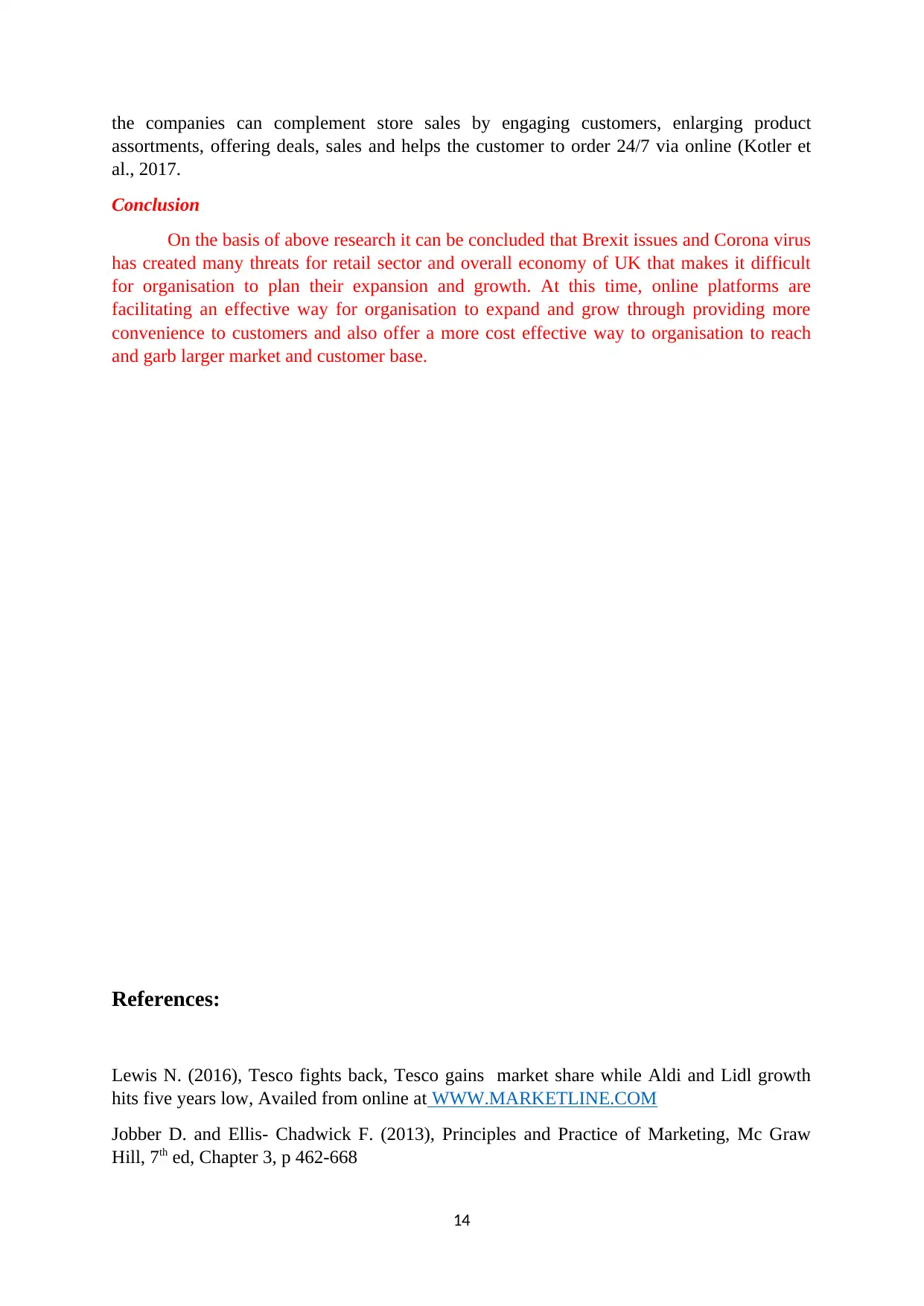
the companies can complement store sales by engaging customers, enlarging product
assortments, offering deals, sales and helps the customer to order 24/7 via online (Kotler et
al., 2017.
Conclusion
On the basis of above research it can be concluded that Brexit issues and Corona virus
has created many threats for retail sector and overall economy of UK that makes it difficult
for organisation to plan their expansion and growth. At this time, online platforms are
facilitating an effective way for organisation to expand and grow through providing more
convenience to customers and also offer a more cost effective way to organisation to reach
and garb larger market and customer base.
References:
Lewis N. (2016), Tesco fights back, Tesco gains market share while Aldi and Lidl growth
hits five years low, Availed from online at WWW.MARKETLINE.COM
Jobber D. and Ellis- Chadwick F. (2013), Principles and Practice of Marketing, Mc Graw
Hill, 7th ed, Chapter 3, p 462-668
14
assortments, offering deals, sales and helps the customer to order 24/7 via online (Kotler et
al., 2017.
Conclusion
On the basis of above research it can be concluded that Brexit issues and Corona virus
has created many threats for retail sector and overall economy of UK that makes it difficult
for organisation to plan their expansion and growth. At this time, online platforms are
facilitating an effective way for organisation to expand and grow through providing more
convenience to customers and also offer a more cost effective way to organisation to reach
and garb larger market and customer base.
References:
Lewis N. (2016), Tesco fights back, Tesco gains market share while Aldi and Lidl growth
hits five years low, Availed from online at WWW.MARKETLINE.COM
Jobber D. and Ellis- Chadwick F. (2013), Principles and Practice of Marketing, Mc Graw
Hill, 7th ed, Chapter 3, p 462-668
14
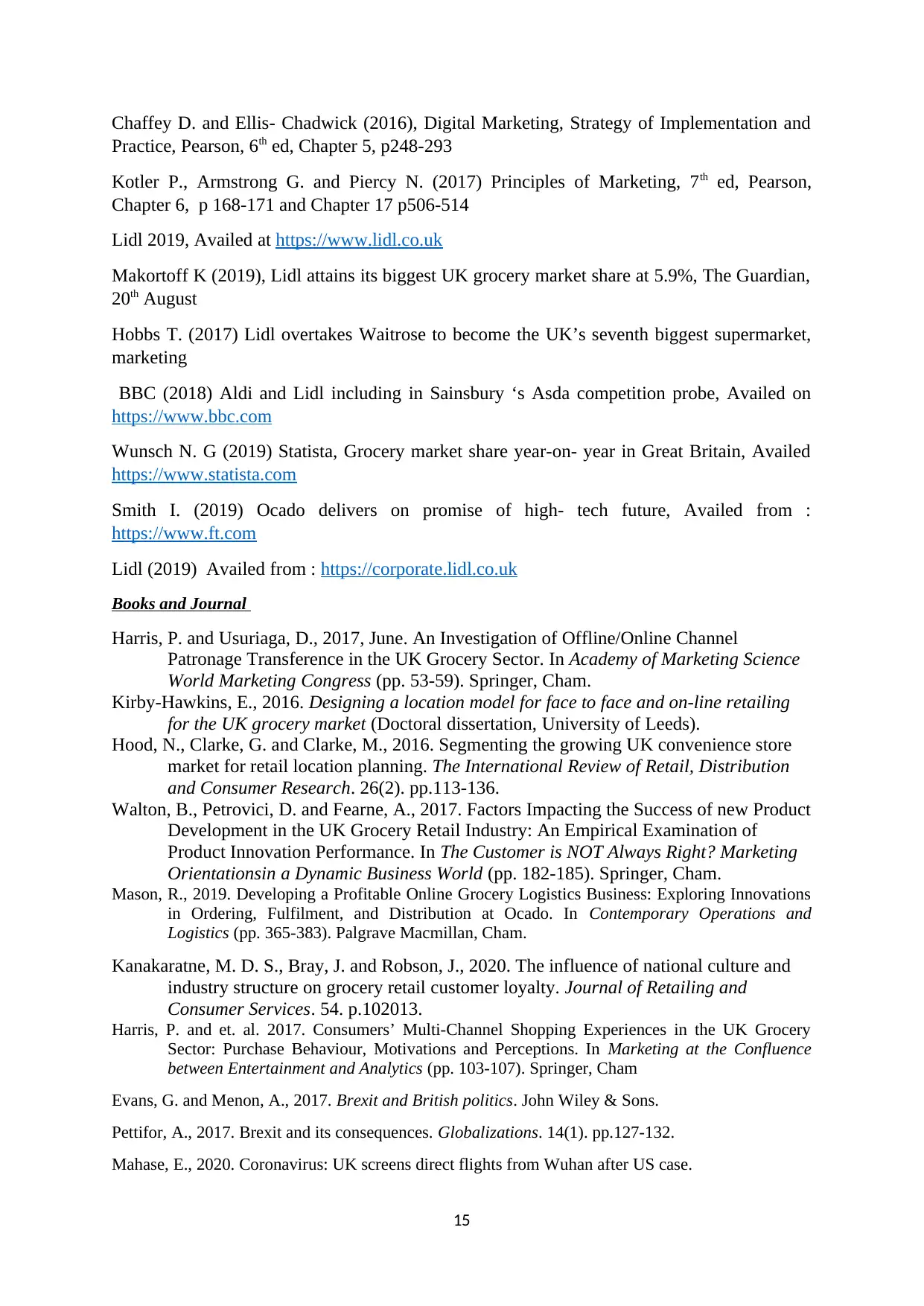
Chaffey D. and Ellis- Chadwick (2016), Digital Marketing, Strategy of Implementation and
Practice, Pearson, 6th ed, Chapter 5, p248-293
Kotler P., Armstrong G. and Piercy N. (2017) Principles of Marketing, 7th ed, Pearson,
Chapter 6, p 168-171 and Chapter 17 p506-514
Lidl 2019, Availed at https://www.lidl.co.uk
Makortoff K (2019), Lidl attains its biggest UK grocery market share at 5.9%, The Guardian,
20th August
Hobbs T. (2017) Lidl overtakes Waitrose to become the UK’s seventh biggest supermarket,
marketing
BBC (2018) Aldi and Lidl including in Sainsbury ‘s Asda competition probe, Availed on
https://www.bbc.com
Wunsch N. G (2019) Statista, Grocery market share year-on- year in Great Britain, Availed
https://www.statista.com
Smith I. (2019) Ocado delivers on promise of high- tech future, Availed from :
https://www.ft.com
Lidl (2019) Availed from : https://corporate.lidl.co.uk
Books and Journal
Harris, P. and Usuriaga, D., 2017, June. An Investigation of Offline/Online Channel
Patronage Transference in the UK Grocery Sector. In Academy of Marketing Science
World Marketing Congress (pp. 53-59). Springer, Cham.
Kirby-Hawkins, E., 2016. Designing a location model for face to face and on-line retailing
for the UK grocery market (Doctoral dissertation, University of Leeds).
Hood, N., Clarke, G. and Clarke, M., 2016. Segmenting the growing UK convenience store
market for retail location planning. The International Review of Retail, Distribution
and Consumer Research. 26(2). pp.113-136.
Walton, B., Petrovici, D. and Fearne, A., 2017. Factors Impacting the Success of new Product
Development in the UK Grocery Retail Industry: An Empirical Examination of
Product Innovation Performance. In The Customer is NOT Always Right? Marketing
Orientationsin a Dynamic Business World (pp. 182-185). Springer, Cham.
Mason, R., 2019. Developing a Profitable Online Grocery Logistics Business: Exploring Innovations
in Ordering, Fulfilment, and Distribution at Ocado. In Contemporary Operations and
Logistics (pp. 365-383). Palgrave Macmillan, Cham.
Kanakaratne, M. D. S., Bray, J. and Robson, J., 2020. The influence of national culture and
industry structure on grocery retail customer loyalty. Journal of Retailing and
Consumer Services. 54. p.102013.
Harris, P. and et. al. 2017. Consumers’ Multi-Channel Shopping Experiences in the UK Grocery
Sector: Purchase Behaviour, Motivations and Perceptions. In Marketing at the Confluence
between Entertainment and Analytics (pp. 103-107). Springer, Cham
Evans, G. and Menon, A., 2017. Brexit and British politics. John Wiley & Sons.
Pettifor, A., 2017. Brexit and its consequences. Globalizations. 14(1). pp.127-132.
Mahase, E., 2020. Coronavirus: UK screens direct flights from Wuhan after US case.
15
Practice, Pearson, 6th ed, Chapter 5, p248-293
Kotler P., Armstrong G. and Piercy N. (2017) Principles of Marketing, 7th ed, Pearson,
Chapter 6, p 168-171 and Chapter 17 p506-514
Lidl 2019, Availed at https://www.lidl.co.uk
Makortoff K (2019), Lidl attains its biggest UK grocery market share at 5.9%, The Guardian,
20th August
Hobbs T. (2017) Lidl overtakes Waitrose to become the UK’s seventh biggest supermarket,
marketing
BBC (2018) Aldi and Lidl including in Sainsbury ‘s Asda competition probe, Availed on
https://www.bbc.com
Wunsch N. G (2019) Statista, Grocery market share year-on- year in Great Britain, Availed
https://www.statista.com
Smith I. (2019) Ocado delivers on promise of high- tech future, Availed from :
https://www.ft.com
Lidl (2019) Availed from : https://corporate.lidl.co.uk
Books and Journal
Harris, P. and Usuriaga, D., 2017, June. An Investigation of Offline/Online Channel
Patronage Transference in the UK Grocery Sector. In Academy of Marketing Science
World Marketing Congress (pp. 53-59). Springer, Cham.
Kirby-Hawkins, E., 2016. Designing a location model for face to face and on-line retailing
for the UK grocery market (Doctoral dissertation, University of Leeds).
Hood, N., Clarke, G. and Clarke, M., 2016. Segmenting the growing UK convenience store
market for retail location planning. The International Review of Retail, Distribution
and Consumer Research. 26(2). pp.113-136.
Walton, B., Petrovici, D. and Fearne, A., 2017. Factors Impacting the Success of new Product
Development in the UK Grocery Retail Industry: An Empirical Examination of
Product Innovation Performance. In The Customer is NOT Always Right? Marketing
Orientationsin a Dynamic Business World (pp. 182-185). Springer, Cham.
Mason, R., 2019. Developing a Profitable Online Grocery Logistics Business: Exploring Innovations
in Ordering, Fulfilment, and Distribution at Ocado. In Contemporary Operations and
Logistics (pp. 365-383). Palgrave Macmillan, Cham.
Kanakaratne, M. D. S., Bray, J. and Robson, J., 2020. The influence of national culture and
industry structure on grocery retail customer loyalty. Journal of Retailing and
Consumer Services. 54. p.102013.
Harris, P. and et. al. 2017. Consumers’ Multi-Channel Shopping Experiences in the UK Grocery
Sector: Purchase Behaviour, Motivations and Perceptions. In Marketing at the Confluence
between Entertainment and Analytics (pp. 103-107). Springer, Cham
Evans, G. and Menon, A., 2017. Brexit and British politics. John Wiley & Sons.
Pettifor, A., 2017. Brexit and its consequences. Globalizations. 14(1). pp.127-132.
Mahase, E., 2020. Coronavirus: UK screens direct flights from Wuhan after US case.
15
Secure Best Marks with AI Grader
Need help grading? Try our AI Grader for instant feedback on your assignments.
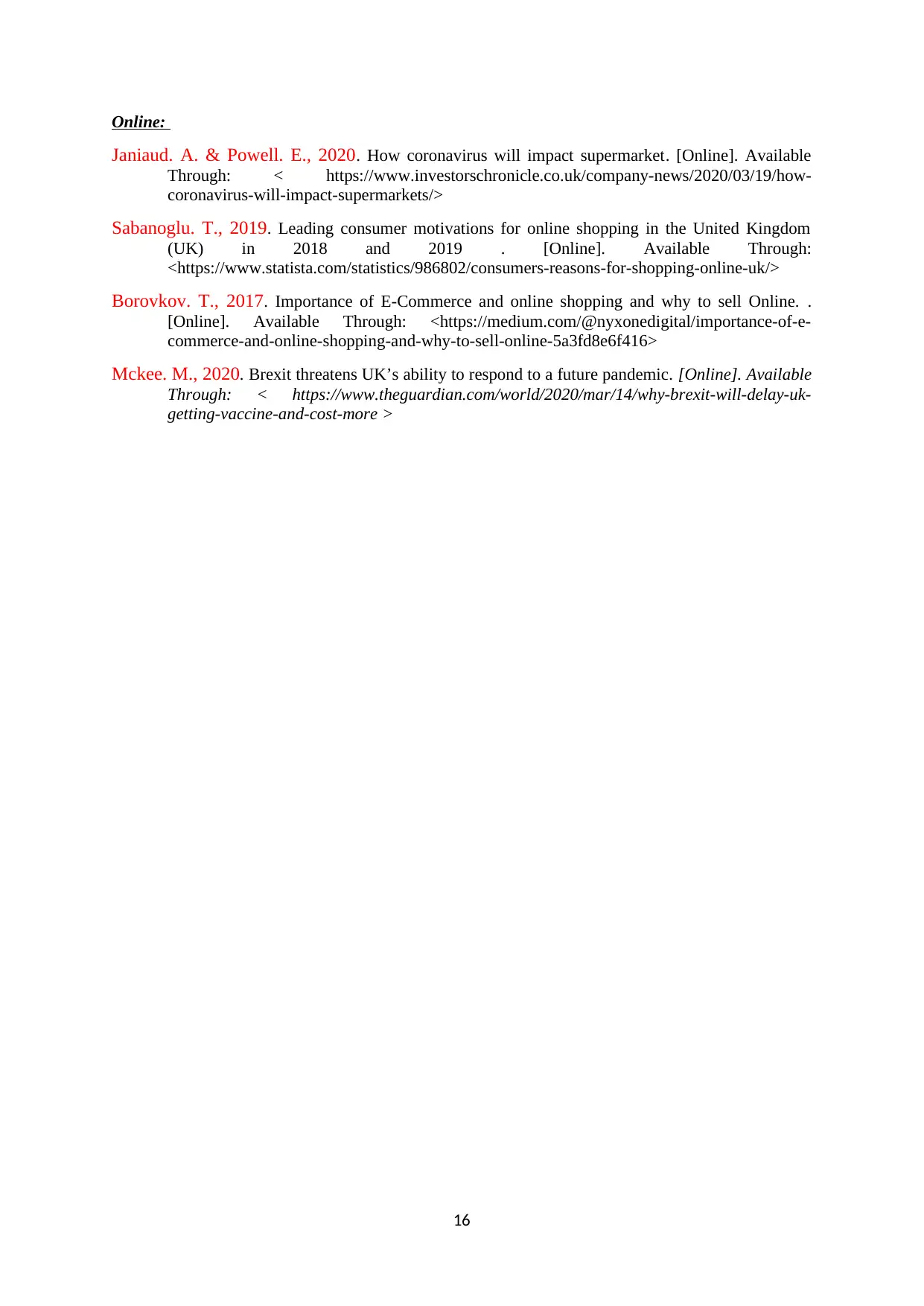
Online:
Janiaud. A. & Powell. E., 2020. How coronavirus will impact supermarket. [Online]. Available
Through: < https://www.investorschronicle.co.uk/company-news/2020/03/19/how-
coronavirus-will-impact-supermarkets/>
Sabanoglu. T., 2019. Leading consumer motivations for online shopping in the United Kingdom
(UK) in 2018 and 2019 . [Online]. Available Through:
<https://www.statista.com/statistics/986802/consumers-reasons-for-shopping-online-uk/>
Borovkov. T., 2017. Importance of E-Commerce and online shopping and why to sell Online. .
[Online]. Available Through: <https://medium.com/@nyxonedigital/importance-of-e-
commerce-and-online-shopping-and-why-to-sell-online-5a3fd8e6f416>
Mckee. M., 2020. Brexit threatens UK’s ability to respond to a future pandemic. [Online]. Available
Through: < https://www.theguardian.com/world/2020/mar/14/why-brexit-will-delay-uk-
getting-vaccine-and-cost-more >
16
Janiaud. A. & Powell. E., 2020. How coronavirus will impact supermarket. [Online]. Available
Through: < https://www.investorschronicle.co.uk/company-news/2020/03/19/how-
coronavirus-will-impact-supermarkets/>
Sabanoglu. T., 2019. Leading consumer motivations for online shopping in the United Kingdom
(UK) in 2018 and 2019 . [Online]. Available Through:
<https://www.statista.com/statistics/986802/consumers-reasons-for-shopping-online-uk/>
Borovkov. T., 2017. Importance of E-Commerce and online shopping and why to sell Online. .
[Online]. Available Through: <https://medium.com/@nyxonedigital/importance-of-e-
commerce-and-online-shopping-and-why-to-sell-online-5a3fd8e6f416>
Mckee. M., 2020. Brexit threatens UK’s ability to respond to a future pandemic. [Online]. Available
Through: < https://www.theguardian.com/world/2020/mar/14/why-brexit-will-delay-uk-
getting-vaccine-and-cost-more >
16
1 out of 17
Related Documents
Your All-in-One AI-Powered Toolkit for Academic Success.
+13062052269
info@desklib.com
Available 24*7 on WhatsApp / Email
![[object Object]](/_next/static/media/star-bottom.7253800d.svg)
Unlock your academic potential
© 2024 | Zucol Services PVT LTD | All rights reserved.





